- New Sailboats
- Sailboats 21-30ft
- Sailboats 31-35ft
- Sailboats 36-40ft
- Sailboats Over 40ft
- Sailboats Under 21feet
- used_sailboats
- Apps and Computer Programs
- Communications
- Fishfinders
- Handheld Electronics
- Plotters MFDS Rradar
- Wind, Speed & Depth Instruments
- Anchoring Mooring
- Running Rigging
- Sails Canvas
- Standing Rigging
- Diesel Engines
- Off Grid Energy
- Cleaning Waxing
- DIY Projects
- Repair, Tools & Materials
- Spare Parts
- Tools & Gadgets
- Cabin Comfort
- Ventilation
- Footwear Apparel
- Foul Weather Gear
- Mailport & PS Advisor
- Inside Practical Sailor Blog
- Activate My Web Access
- Reset Password
- Customer Service

- Free Newsletter


Pearson 37 and 37-2 Used Boat Review
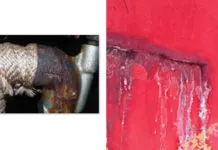
DIY Survey Checklist for Used-Boat Buying

Valiant 40: Reshaping the Cruising Hull
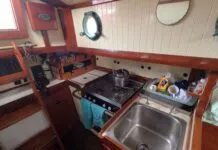
Bristol Channel Cutter 28: Circumnavigator’s Choice

Best Crimpers and Strippers for Fixing Marine Electrical Connectors

Thinking Through a Solar Power Installation

How Does the Gulf Stream Influence our Weather?

Can You Run a Marine Air-Conditioner on Battery Power?

Practical Sailor Classic: The Load on Your Rode

Anchor Rodes for Smaller Sailboats

Ground Tackle Inspection Tips

Shoe Goo II Excels for Quick Sail Repairs
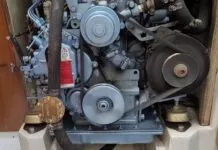
Spring Season Engine Start-Up for Winterized Engines
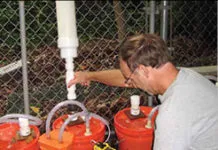
Solutions for a Stinky Holding Tank
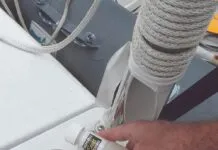
Diesel Performance Additives
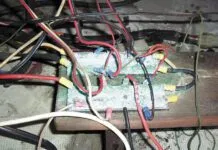
Hidden Maintenance Problems: Part 3 – Gremlins in the Electrics

Seepage or Flooding? How To Keep Water Out of the Boat
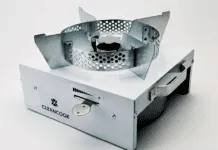
Alcohol Stoves— Swan Song or Rebirth?
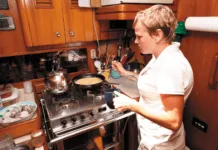
Living Aboard with an Alcohol Stove
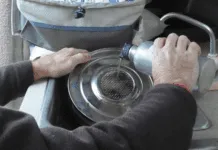
Choosing the Right Fuel for Your Alcohol Stove

Preparing Yourself for Solo Sailing

How to Select Crew for a Passage or Delivery

Preparing A Boat to Sail Solo

Re-sealing the Seams on Waterproof Fabrics

Chafe Protection for Dock Lines

Waxing and Polishing Your Boat

Reducing Engine Room Noise

Tricks and Tips to Forming Do-it-yourself Rigging Terminals

Marine Toilet Maintenance Tips
- Sailboat Reviews
O’Day 22
A nice cockpit, a touch of privacy and good looks, but performance is not a strong suit here..
O’Day Boats was around a long time by fiberglass boatbuilding standards—about 30 years. Originally O’Day was a leader in small boats typified by the Fox-designed Day Sailer.
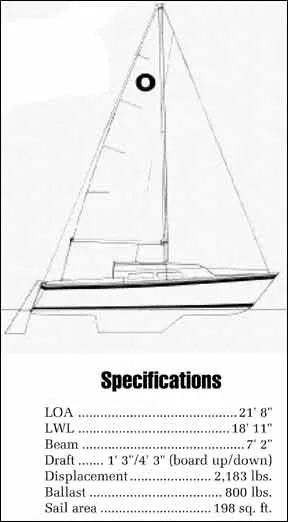
By the early ’70s O’Day had moved into the trailerable cruising boat market. In the meantime the firm was acquired by Bangor Punta along with such other major boat builders as Cal and Ranger Yachts. In later years, with the decline in volume sales of small boats, O’Day had problems. To help alleviate these, O’Day produced larger and larger boats, first a 30, then a 32, and more recently a 34 and a 37.
All the cruising size boats in the O’Day line were designed by C. Raymond Hunt Associates in one of the most enduring designer-builder relationships in the industry (rivaled, in fact, only by Bill Lapworth’s tenure as Cal’s house designer and Bruce King’s with Ericson Yachts). The result of the relationship is a family resemblance in the O’Day line that is more than superficial. What proves popular in one boat is apt to be adopted in subsequent kin. Therefore, any study of the O’Day offerings over the years reflects a process of evolution.
When it was introduced, the O’Day 22 was touted as a competitive contender on the race course, a contrasting companion to the rather hazy 23-footer which it would soon phase out. The 22 had a masthead rig, a stylish rake to the transom, shallow (23″) draft with a short stub keel and no centerboard, light weight (advertised 1,800 lbs) for trailering, and a price under $3,000.
Later, the 22 acquired a fractional rig, a centerboard, 300 advertised pounds and a price tag almost $7,000 higher.
Construction
O’Day once set a standard for small boat construction and styling. That was before on and off labor problems in its plant, management changes under Bangor Punta, the decline in sales of boats in its size range, and increasingly fierce competition for buyers who became more cost than quality conscious. The later O’Day 22s were, frankly, a mixed bag of quality and shabbiness.
The spars, rigging, and hardware are as high quality as we have seen in comparable boats. Our only reservation is with the stamped stainless steel hinged mast step that we know from personal experience requires a steady hand and boat when raising or lowering a mast.
We also think that a mainsheet which terminates in a cam action cleat 16″ up the single backstay may be economical and simple but it is neither efficient nor handy, again a reflection of scrimping to keep price low.
The quality of O’Day fiberglass laminates was historically high but there have been reader reports of gelcoat voids and there is consistent evidence of print through (pattern of laminate in gelcoat). Exterior styling and proportions are superb, an opinion iterated by owners who have returned the PS Boat Owners’ Questionnaires. The O’Day 22, despite her age, is still not outdated.
On a boat of this size and price, a minimum of exterior trim is understandable. What is less understandable is the poor quality of the interior finish and decor. Belowdecks the O’Day 22 epitomizes the pejorative label Clorox bottle , used to describe fiberglass boats. Sloppily fitted bits of teak trim are matched against teak-printed Formica, at best a tacky combination. Cabinetry, such as there is, is flimsy, and in general the whole impression is of lackluster attention to details.
Performance
Without a centerboard the O’Day 22 simply did not have the performance to go with her racy image. Even with the centerboard she is hardly a ball of fire under sail. She does not point well; tacking through 100 degrees is not uncommon and she is tender, with a disconcerting desire to round up when a puff hits. In light air, with her 3/4 fore triangle and working jib she is under-canvassed and sluggish. In such conditions a genoa with substantial overlap is essential.
Since changing jibs is at best a dicey exercise on a 22 footer, the first step in reducing sail is to reef the mainsail. Jiffy reefing is standard and owners of the O’Day should have a system in good working order and know how to use it. Owners of the boat in waters where squalls are a threat may also want to consider roller furling for the larger jib, trading off the loss of performance and added cost for such a rig for the convenience and, in the case of this boat, the safety.
The O’Day is most hurt in light air downwind and most owners will want either an 8′-or-so whisker pole for winging the jib, or a spinnaker. It is a fun boat on which to learn spinnaker handling. With her fractional rig the spinnaker is relatively small and yet the boat is big enough to provide a foredeck platform for setting the sail.

The trouble is that the O’Day 22 scrimps on the hardware needed for ease of handling with or without a spinnaker. The two #10 Barient sheet winches are, in our opinion, inadequate for anything larger than a working jib and we suggest replacing them with optional #16s. Similarly, the working jib sheets lead to fixed blocks whereas lengths of track with adjustable blocks (fitted to some boats as an option) are far better for optimizing sail trim.
The O’Day did not come with halyard winches as standard. It is a large boat for setting and reefing sails with hand tension alone. Most owners will want at least one small winch (#10) on the cabin roof, with the jib and main halyards led aft through jam cleats or stoppers to the winch.
The fairing of the O’Day 22 underwater is better than average, helped by the fact that the lead ballast is encapsulated in the fiberglass hull molding. The centerboard will, however, be difficult to maintain.
Like many other boats of her size on the market, the O’Day 22 is basically a daysailer with incidental overnight accommodations, notwithstanding that her builder (or its ad agency) made much of its questionable comfort, privacy, and space.
The cockpit of the O’Day is almost perfect: a spacious 6-1/2′ long, the seats are spaced to allow bracing of feet on the one opposite, and the coaming provides a feeling of security and serves as a comfortable arm rest. It is also self-bailing although the low sill at the companionway means that the lower hatch board must be in place to prevent water going below in the event of a knockdown.
Seat locker space is excellent for a boat of this size with quarterberth below and we like the separate sealed well for the outboard remote gas tank (but not the fact that the hose can be pinched in use).
O’Day literature boasts berths for two couples in “absolute privacy.” Privacy in a 22 footer has to be one of the more relative features. A sliding door encloses the forward cabin and another, the head.
The layout of the O’Day 22 is a noteworthy example of the tradeoff between an enclosed head and berth space. It does indeed have a head area that can be enclosed, a rare feature indeed on a boat of this size. With a conventional marine toilet and throughhull discharge where permitted, this would be a most serviceable facility.
The tradeoff is a pair of terrible vee berths forward. Coming to a point at the forward end, there is simply not enough room for two adults on even the most intimate terms. They are thus suitable only for a pair of small children who do not suffer from sibling rivalry.
By contrast the two settee berths in the main cabin are a bit narrow but a fit place for two adults to sleep. In contrast to the dinette layout of other boats, we think the more traditional layout of the O’Day would be the choice for most owners, especially those cruising with children. However, the settees are not comfortable to sit on, lacking as they do backrests.
The initial version of the O’Day had the then fashionable dinette arrangement but this was quickly replaced by a pair of opposing settees. We doubt if many owners would bother setting up the portable cabin table between the berths, as it prevents the fore and aft passage through the cabin.
The galley with its small sink and space for a twoburner stove is rudimentary but adequate for a boat of this size, Inadequate is the bin/hanging locker opposite the head. Its usefulness escapes us. Enclosed, it could have been better used space. But then the O’Day 22 desperately needs stowage space.
Conclusions
At a minimum trailering weight of 2,200 lbs. (more realistically 2,500 plus the trailer), the O’Day 22 is above the maximum for trailering without a heavy car and special gear.
If she isn’t going to be trailered and launched off a ramp, the 2′ minimum draft is an unwarranted sacrifice of performance and stability. We would look for a fin keel boat unless shoal draft is the highest priority.
On the other hand, with some additional sails and hardware the O’Day 22 should appeal to the sailor who wants a minimum size (and therefore price) boat primarily for daysailing and occasional weekend cruising (maximum one couple plus two young children).
Clearly the O’Day 22 is a minimum boat built tightly to a price. She is attractively styled. As she is apt to be a first boat, resale is important. O’Day boats have enjoyed good value on the used boat market. For about $6,000 for a ten-year-old model, you get a sleek looking small boat with a good cockpit, a modicum of privacy and two good berths. You also get a schlocky decor and a slow boat.
RELATED ARTICLES MORE FROM AUTHOR
hi, do you sell parts for boat 22ft o-day ? are you in england ? the part i want is the part the black boat
LEAVE A REPLY Cancel reply
Log in to leave a comment
Latest Videos
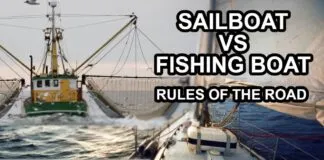
Sailboat vs Fishing Boat – Rules of the Road

Catalina 445: What You Should Know | Boat Review

How to Wax and Polish Your Boat

Beneteau 46.1: What You Should Know | Boat Tour
- Privacy Policy
- Do Not Sell My Personal Information
- Online Account Activation
- Privacy Manager
Great choice! Your favorites are temporarily saved for this session. Sign in to save them permanently, access them on any device, and receive relevant alerts.
- Sailboat Guide
O'Day 22
O'Day 22 is a 21 ′ 8 ″ / 6.6 m monohull sailboat designed by Raymond Hunt (C.R. Hunt & Assoc.) and built by O'Day Corp. between 1972 and 1983.

Rig and Sails
Auxilary power, accomodations, calculations.
The theoretical maximum speed that a displacement hull can move efficiently through the water is determined by it's waterline length and displacement. It may be unable to reach this speed if the boat is underpowered or heavily loaded, though it may exceed this speed given enough power. Read more.
Classic hull speed formula:
Hull Speed = 1.34 x √LWL
Max Speed/Length ratio = 8.26 ÷ Displacement/Length ratio .311 Hull Speed = Max Speed/Length ratio x √LWL
Sail Area / Displacement Ratio
A measure of the power of the sails relative to the weight of the boat. The higher the number, the higher the performance, but the harder the boat will be to handle. This ratio is a "non-dimensional" value that facilitates comparisons between boats of different types and sizes. Read more.
SA/D = SA ÷ (D ÷ 64) 2/3
- SA : Sail area in square feet, derived by adding the mainsail area to 100% of the foretriangle area (the lateral area above the deck between the mast and the forestay).
- D : Displacement in pounds.
Ballast / Displacement Ratio
A measure of the stability of a boat's hull that suggests how well a monohull will stand up to its sails. The ballast displacement ratio indicates how much of the weight of a boat is placed for maximum stability against capsizing and is an indicator of stiffness and resistance to capsize.
Ballast / Displacement * 100
Displacement / Length Ratio
A measure of the weight of the boat relative to it's length at the waterline. The higher a boat’s D/L ratio, the more easily it will carry a load and the more comfortable its motion will be. The lower a boat's ratio is, the less power it takes to drive the boat to its nominal hull speed or beyond. Read more.
D/L = (D ÷ 2240) ÷ (0.01 x LWL)³
- D: Displacement of the boat in pounds.
- LWL: Waterline length in feet
Comfort Ratio
This ratio assess how quickly and abruptly a boat’s hull reacts to waves in a significant seaway, these being the elements of a boat’s motion most likely to cause seasickness. Read more.
Comfort ratio = D ÷ (.65 x (.7 LWL + .3 LOA) x Beam 1.33 )
- D: Displacement of the boat in pounds
- LOA: Length overall in feet
- Beam: Width of boat at the widest point in feet
Capsize Screening Formula
This formula attempts to indicate whether a given boat might be too wide and light to readily right itself after being overturned in extreme conditions. Read more.
CSV = Beam ÷ ³√(D / 64)
One of the most successful of all O’Day models with more than 3000 built. A fractional rig was adopted after 1980 (as shown here). Available with keel/cb and fixed keel. (The version with a mashead rig listed here as O’DAY 22 MH)
Embed this page on your own website by copying and pasting this code.

Discover Related Sailboats

O'Day 22 MH
- About Sailboat Guide
©2024 Sea Time Tech, LLC
This site is protected by reCAPTCHA and the Google Privacy Policy and Terms of Service apply.
O'day 22
The o'day 22 is a 21.67ft fractional sloop designed by c. raymond hunt & assoc. and built in fiberglass by o'day corp. between 1972 and 1983., 3159 units have been built..
The O'day 22 is a light sailboat which is a reasonably good performer. It is reasonably stable / stiff and has a low righting capability if capsized. It is best suited as a day-boat.
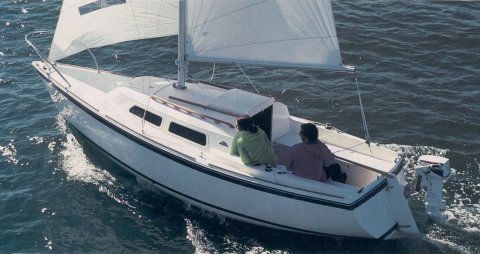
O'day 22 for sale elsewhere on the web:

Main features
Login or register to personnalize this screen.
You will be able to pin external links of your choice.

See how Sailboatlab works in video

We help you build your own hydraulic steering system - Lecomble & Schmitt
Accommodations
Builder data, other photos.
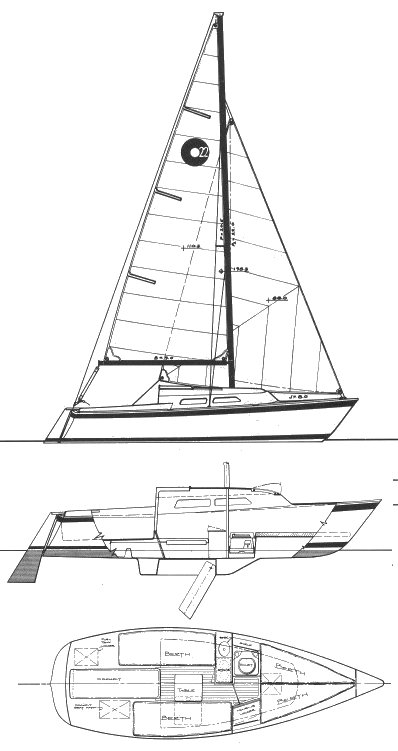
Modal Title
The content of your modal.
Personalize your sailboat data sheet

Boats for Sale
22' o'day sailboats for sale.
Connecting with Marinesource.com
Copyright 1992-2024 MarineSource Network, Inc. All Rights Reserved.

- Sign In or Register
- Boats for Sale
- Research Boats
- Sell a Boat
- Search Alerts
- My Listings
- Account Settings
- Dealer Advertising
- 22 O Day Sailboat
22 O Day Sailboat Boats for sale

1981 O'Day 22 Sailboat
Bay St. Louis, Mississippi
Make O'Day
Category Cruiser Motorcycles
Length 22.0
Posted Over 1 Month
I have for sale a 1981 O'Day 22 MH Sailboat. $3200 OBO This boat has a 4.5HP 2 stroke Johnson Seahorse outboard. The motor runs great and starts on the second pull. Very light motor. This is a great boat if you are an experienced sailor or just starting out. The battery is new (purchased 10/3/14). it is a deep cycle battery. I will also include a trickle charger. The sails are is great shape. The cushions could be redone to make it perfect. It has a swinging Keel. The Keel is stored under the boat instead of inside the cabin. New bottom paint May 2014 The draft is 1.9 feet (from the water line to the bottom of the keel). it would probably float good loaded up in about 2.5 feet of water. This boat is located in Bay St. Louis, Ms The boat is registered in Mississippi in my name. The interior wood has been refinished & stained previously. The tiller has also been refinished. I also have a device i made to raise the mast. it is a 2x4 with a mount that connects to the bottom of the mast. You hook the front mast support up to the device, and from the device to the front of the boat through the rigging. i have a boat winch on the device & some rigging. this allows the mast to come up with ease. Just crank it right up. 1 person could probably do it, but i usually have someone else help me to keep the mast from moving left or right while raising. I do not leave the boat in the water. I launch & rig up every outing. I keep the boat at my home while not in use. This boat come with the following: 2 jib sails. A standard jib (smaller) & a Genola Jib (Overlapping). 1 Main Sail several new rigging block pulleys new rope (4800 lb) new main sail block pulley assembly new boom vang block pulley assembly gas tank with new fuel line, bulb, & fuel filter. new interior lights & 12V plugs new compass - not installed new wiring throughout the boat - within the past year 1 single axle trailer Adjustable Transom 2 anchors & 100 ft of 4800 lb double braided line. 4 Life Jackets Canister Horn 4 Emergency Flares Throwable flotation/Cushion fresh water holding tank & sink - i have never used it. Tarp cover & bungee cords This sale comes with everything you need for sailing & to be legal on the water. all you have to do is register and you will be ready to go. this boat needs absolutely nothing. This boat does great in rough water. I have had no issues. It is ready to sail. This boat is rigged to be sailed by 1 person if desired. (2 will be required to raise the mast) You can raise & lower the sails per the rigging toward the seating area. The boat launches with ease. i dont have to set my rear truck tires in the water to launch. The trailer tires are about 3 years old. The boat will sleep 4 people. There are Berths on each side in the back of the Cabin and a V-Berth in the front. I have taken very good care of this boat. I wash it after every outing. Navigation Lights work great. I am available to show the boat anytime after 5 pm M-F and anytime on Saturday & Sunday. I do not need help selling. This is for a cash only in person sale. Pickup Only
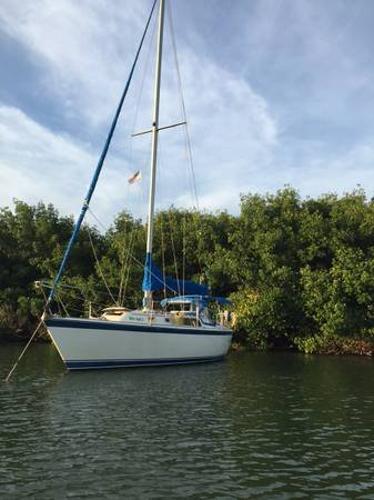
1982 O'Day 302
Fort Myers Beach, Florida
Category Sailboats
1982 O'Day 302 1982 30' Wing Keel O'Day Sailboat 22,500.00 OBO Beautiful boat owner lived aboard for some time and kept it maintained. Great day sailing and weekend boat with lots of upgrades. Well kept and maintained, very sturdy solid boat. We've owned since 2012 and have enjoyed sailing this boat from St Pete and Clearwater to Fort Myers and Marco Island with lots of stops in between. We're upgrading to larger boat and moving to the Caribbean. New stuff: Raymairne Evolution EV-100 Wheel Sail Auto Pilot ($1599)New 30 amp plug and line to breaker boxGalley faucet and under sink filter for drinking waterBottom job is two years old, monthly cleaningHead pumpWater pumpCabin and cockpit cushions3000 Watt InverterTwo new batteries, 3 batteries totalElectrical wiringFridgeJib linesMain sheet line into cockpitNew Rudder and Steering RadialStuffing box New heat exchanger approx 100 hours agoAC power box and thermostat, AC recently acid washedWifi antenna, Bad Boy Extreme (7 mile range)List of specs (categories)Engine: Yanmar 24 HPCapacities: 20 gal fresh water, 6 gal hot water, 9 gal holdingSails: 1 Main, 1 JibElectronics: GPS, Depth, Auto HelmGround tackle: 2 Anchors, 22 lb delta on bow roller with 30' of galvanized 5/16" chain. 180 1/2" nylon' line. 20 lb Danforth 15 feet chain and 100' 1/2" nylon line in anchor locker.Convenience: Stereo/cd, flat screen tv , HD antenna Galley: induction hot plate, Head: Manual PumpCockpit: Cushions

23' O'DAY SAILBOAT COMPLETELY REFURBISHED
Palmdale, California
23' O'DAY SAILBOAT WITH TRAILER IN EXCELLENT REFURBISHED CONDITION This boat has received very little use since the complete refurbishment It is ready for the new buyer to move aboard and sail. No additional equipment required for a complete sailing experience. NEW REDUCED PRICE SAVE $5000 1981 O'DAY SAILBOAT & TRAILER A Beautiful 23' O'Day Sailboat completely restored and refinished in 2013. No cost was spared in outfitting this boat for a couples vacationing for a night or a month. Will accommodate and sleep four. Approximately $16,000 was spent on the complete refurbishment in 2013. Equipped with the following: 1. Outside hull completely refinished in 2013 by Driscoll Marine in San Deigo, CA Newly sealed and bottom coated. No blister, scrapes, cuts or blemished noted.2. Inside interior was in excellent condition all fabric dry cleaned and scotchguard protected. All wood cleaned and refinished. 3. Completely new 12VDC and 120VAC wiring and electrical panels with the following: New switches & Circuit breakers All new wiring 12 & 120 volt New LED running lights New mast mounted fore & aft deck lights 800 watt 120VAC inverter New marine batteries (2) New marine battery switch (4) 120VAC outlets New VHF radio & new antenna 12VDC convenience outlets in cockpit and V-berth (14) LED interior illumination lighting 4. New Tohatsu 8HP 4 stroke long shaft electric start with generator outboard, less than 3 hours useage. 5. Midships radio or navigation station above the new push button heard.Drop down folding Galley Table amidships 6. Sails in excellent condition consists of: 100% Jib, main cleaned & refurbished in 2014 by Sail Care, 150% genoa and newly refurbished Ulmer Tri-Radial Spinnaker. Refurbished by North Sail. 7. All standing and running rigging replaced 2013. This includes all associated hardware like turnbuckles, snap shackles etc. Masthead removed and sheaves reworked or replaced. 8. All new plumbing, consisting of: New galley sink All new water lines New pressure on demand water pump New 2 1/2 gallon hot water heater New hot & cold cockpit shower New 12 gallon water tank 9. New Garmin GPS/fishfinder Chart-plotter combination cockpit mounted and weatherproof' 10. New Sailboat bulkhead mount compass, LED illuminated . 11. 1 new Danforth type anchor and 1 refurbished anchor with new anchor chain & lines. 12. Four new dock lines with set of extra lines 13. All sheets and halyard run aft to cockpit for single handed sailing New boom vang for mainsail. 14. Trailer custom modified for this boat. Very easy to trailer. I used a Toyto Highlander Hybrid to trailer up and down mountains and long distances. Trailer has new brakes and electrical lights. Trailer was custom modified by Driscoll Marine. 15. New compact microwave oven mounted mid-shipsSS BBQ Gas Grill in Cockpit. 16. New galley stove and eating utensils. 17. Wireless weather station mounted atop the mast with readout in cabin or cockpit. 18. (4) New un-opened lifejackets with (1) type 4 auto-inflating life harness for the helmsman. 19. (3) throwable type life saving devices. 20. (2) stadium type cockpit seats with backrests. 21. Outboard is mounted on spring loaded OB bracket for easy raising and lowering.22. New AM/FM/Cassett/CD Sony Receiver Sound System with Stero Speakers. Many more extras. Please call for specific information. At this time the boat is on trailer at Big Bear Lake, ready to launch and use or ready to trailerby lowering and securing mastThis Boat is ready to use and camp on, just add water. The buyer will receive years of wonderful sailing experiences without having to perform any major repairs or replacements. At this time the boat is on trailer at Big Bear Lake, ready to launch and use or ready to trailerby lowering and securing mast

1974 Oday 22 Sailboat and trailer
Spanaway, Washington
Roomy layout sleeps 4 with private head with door. Shoal draft keel is a simpler setup with no maintenance needed like swing keel boats have. The O'Day 22 had an enclosed head and hanging locker, more rake to the transom andshorter & higher cabin house than 222. It had 2 windows on each side, jib sheets led toblocks on side decks and cleats (winches also) on cockpit combings. From 1973 to 1979 the 22 had a masthead sloop rig.Equipped with both Working jib and Genoa in addition to the main sail. Trailer is not pretty but tows well and is in working condition. For additional information, reply to this ad or see: http://www.vflyer.com/home/crlk?id=294379003&ps=16 vFlyer ID: 294379003
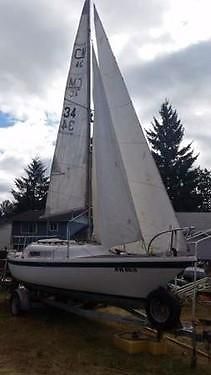
Clipper Marine 23 Poptop sailboat & trailer
1977 Clipper Marine 23 Poptop sailboat & trailer Photos Has new winch and swing keel cable. 4 Teak handrails just redone. galvanized trailer. Has Main, Jib, Genoa, and staysail, and in good shape except for a few stains. Auxillary motor mount will hold 9.9 outboard Also available are Tohatsu 6hp or Mariner 15 hp motors and Northwest 21 O'Day 22 MacGregor 25 For additional information, reply to this ad or see: http://www.vflyer.com/home/crlk?id=293869026&ps=16 vFlyer ID: 293869026

1986 O'Day 27 Foot Salboat w/ 4 Stroke Outboard, Wheel and Pedestal
Oyster Bay, New York
O'DAY 1986 MODEL 272 SAILBOAT Great day sailer - on the hard in Port Washington, NY includes launching in the water. She is a mast head sloop w shoal draft wing keel, and Edson pedestal wheel steering and Doyle Stack Pak. LOA: 27.0 LWL: 22.92 Beam: 9.0 Draft: 2.92 Water Tank: 25 gallons Displacement: 5,375 Ballast: 1,930 Engine: Yamaha 4 stroke outboard gas engine Designed by Hunt & Associates and Built by O'Day Corp (USA). First built 1985 and last built 1989. Vessel is equipped with West Marine VHF radio, Ritchie pedestal mount compass. Galley has Kenmore microwave, 2 burner Origo 4000 cooktop, storage. Sleeps four, enclosed head, two single settee berths and doubles forward and aft. Doyle sails, main sail and roller furling Genoa. Photos: www.sellyourboatnow.shutterfly.com
Used Outboard Motors & Repairs 619
El Cajon, California
We buy, sell, trade, tune-up, and repair all brands, years, sizes and lengths of outboard motors including: Johnson, Evinrude, Mercury, Sears, Wards, Mariner, British Seagull, SeaKing, Clinton, Elgin, Eska, Aero Marine, Gamefisher, Cruise'n Carry, Force, Ted Williams, and numerous others in addition to: Honda, Nissan, Suzuki, Tanaka, Tohatsu, Yamaha, etc. We also carry used propellers for most of the above brands (it is best to bring your old propeller or outboard with you for a perfect fit). We have some lower units, power tilt and trim units, various used electric starters and small electric trolling motors for sale (great for kids on a small boat on a lake). Turn-around time, for carry-in repairs is about 5 business days or less.(depending on parts availability). A larger motor attached to your boat usually takes 1 to 2 days. We also rebuild electric and pull-starters for all motors and we have a huge selection of used outboard motors for sale ranging from 1hp to 250hp. All our motors have been serviced and ready to go. We do remove and install large outboard motors of all sizes. Call Marty at 619 - 972 - 9998 to discuss your motor. If no answer, please leave a message and I will get back to you as soon as possible. Please repeat your phone number twice because sometimes it is not clear. Often we can help you fix your problem on the phone at no cost. (Please no E-mails or texts). When you bring it in, we will give your outboard motor a compression and spark test, diagnose your engine, and tell you what it needs in repairs to get it back in good running condition. We will repair your motor at your request, answer your questions and make suggestions. Most of our business is by recommendation of satisfied customers. We will do everything possible to make you one. If we do not have the size or brand of outboard that you are looking for, ask us to put your name on our list and we will call you if and when such an outboard arrives. ------------------------------------- USEFUL TIPS & INFORMATION: ------------------------------ (1) All 2 stroke outboard engines made after 1963 require a 50:1 mixture (3 ounces of 2 stroke outboard motor oil per gallon of gas). The actual amount is 2.6 ounces per gallon (a little extra won't hurt, but less can cause severe damage to your engine). NOTE: NEVER use 100:1 as recommended by some manufacturers. It will cause your engine to lose compression and die prematurely. The only lubrication that your engine gets is from the oil that is mixed with the gas, therefore use 50:1 to be safe. (2) Older outboards (pre 1963) require double the amount of oil 25:1 mixture (6 ounces per gallon), some require a 16:1 mixture (8 ounces per gallon), and BRITISH SEAGULL engines require a 10:1 mixture (13 ounces per gallon). (3) 4 stroke outboards do not need oil mixed with the gas. Make sure the crankcase is full of oil (check the dipstick). If by mistake you ran your 4 stroke with oil mixed with gas do not be concerned. It's OK. (4) Always carry a minimum amount of tools like screwdrivers (blade and Phillips head), socket set including a spark plug socket, combination wrenches, vice grips, pliers, fire extinguisher, drift or punch to drive out a broken shear pin, a can of WD - 40, and a spray can of carburetor cleaner for starting emergencies, and a few extra new spark plugs (pre-gapped) in case yours become fouled, a new gas filter if your gas line has one, a tire pressure gauge, a long magnet and (extra-long) forceps (in case you drop a nut or a bolt), and a small flashlight. AVOID USING STARTER FLUID because it contains ether (bad for outboards). Also carry a pair of extra shear pins and cotter pins (for most outboards less than 35hp). And also a few small hose clamps to tighten a loose or leaking fuel line (see tip #53 below). (5) For small outboards under 40hp, keep the clamp handle screws greased so they will not freeze up from oxidation or salt. (6) For all outboards that have remote steering, grease the steering cable often if you go out in salt water to prevent the cable from "seizing up" and causing a costly repair. (7) For all outboards, starting it several times a year keeps everything "limber". (8) For all outboards, flushing your outboard in fresh water for 5 minutes after each saltwater use will prevent costly cooling system repairs. NOTE: Do not flush your motor in saltwater. Use a barrel, or a garden hose hooked up to outboard "earmuffs" or any other device made for your motor. (9) If you carry your small outboard motor in the bed of a pick-up truck, always tie it down securely or it might break the tiller or shift handle by rolling. (10) For all outboards, check your propeller for broken blades or chunks missing from any blade. Operating any outboard with uneven prop blades will cause vibration and damage to seals and other internal parts of the lower unit. Also it is best to carry a spare prop. (Approx. cost $50 for a used one) . (11) Spray a thin coat of WD 40 all around the powerhead of your outboard. It will not make your engine run better, but it will protect it from rust and salt deposits. (12) For pull start outboards, check the entire pull cord for signs of wear. You wouldn't want to break a pull cord when you are out fishing. (13) For electric start outboards, always carry 2 fully charged batteries in case one battery loses its charge. (14) For small (tiller steering) outboards up to 35hp, attach a short chain, cable or heavy rope (one end attached to your outboard's clamp section, and the other end attached to the transom of your boat) as a safety to prevent your motor from falling overboard. (15) For all outboards, in the event that you remove the top cowling to check your engine, put the cowling down away from the edge of the boat since any wave might send the cowling to the bottom of the ocean or lake. It will be difficult to locate a replacement. (16) For all outboards, most engine failure is a result of overheating. Always check the temp. gauge (if you have one) or by watching the "pisser". If you see steam coming out, shut the engine to avoid costly damage. Check the bottom of the lower unit to see if you picked up some vegetation, or a plastic bag which may be blocking your water intake. If you do not find anything, you may have a bad impeller or a bad water-pump housing. The best thing to do is, try (if possible) to get towed back by any good natured person in the area, or call "VESSEL ASSIST". If you do not have "Vessel Assist Insurance", it will be quite costly. To avoid all of the above, it is best to change your impeller every 2 years or sooner. Whether you use your outboard frequently, occasionally, or just once in 2 years, it is time more than wear that ruins the impeller. (17) If you own a boat (any kind), always remember to replace the drain plug in the stern (rear) before you go out, or the boat will slowly fill with water. This event happens to everyone at some time. It is best to make a check list and review it before you launch. (Also keep a spare drain plug near the drain-hole in your boat in case the original one gets "lost"). (18) For portable outboards, it is best (if possible) to mount the motor on land before you launch in the ocean, because any wave can cause you to drop your motor while you are mounting it. (19) For outboards with an integral gas tank (one that is built-in to your engine), always carry extra fuel and a FUNNEL, or much of the extra gas will be lost when pouring to re-fill your integral tank. (20) For pull-start outboards and some bigger electric starting engines, you should have a separate emergency starter rope with a handle in case your starter spring fails, or the rope tears, or the electric starter or battery fails. (21) For all outboards, it is wise to remove the propeller after several times of use, in order to remove the fishing line that sometimes collects there. This fishing line can cut through the prop seal and cause the lower unit to leak oil and take in water. (a costly repair). (22) Gasoline should be fresh (not more than 6 months old). If you choose to keep it longer, add the correct amount of STABIL. (23) For all trailered boats, (large and small) you should check the transom of your boat for stress cracks (caused by the motor bouncing because of bumps in the road). To prevent such cracks you should get a TRANSOM SAVER which takes the weight off your boat's transom and transfers it to the trailer. (It costs about $75, and can save you thousands). (24) For all outboards, check the lower unit gear oil. It should be dark brown or black in color. Water or coffee-n-cream color in the oil indicates a lower unit seal problem. Smelly/stinky oil is usually OK as long as the color is good. The gear oil should be changed annually. (25) For outboards up to 35hp, if you cannot get the boat to plane, try adjusting the tilt pin. If the boat still rides with its "nose" high in the air, it is probably because you have too much weight in the rear or (you may possibly have the wrong length lower unit). One remedy is to install a "WHALE TAIL" on the cavitation plate of your outboard to cause a greater lift in the rear. (It costs about $50). (26) For all boat trailers, you should get a BEARING BUDDY for each wheel. Its purpose is to keep the whole hub and wheel bearings greased and to prevent any water from entering the bearing zone when you back into the water. Keep it full of grease (with a grease gun). Without BEARING BUDDYS you can expect the bearings to seize-up sometime when you are trailering. You might snap an axle, lose control of your trailer, drop your boat off the trailer onto the road, or worse. BEARING BUDDYS are inexpensive and easy to put on. They can be found at any boat shop or automotive parts place. (27) For outboard engines that are partially submerged in saltwater for 3 months or longer, you can expect the lower unit's aluminum housing to begin disintegrating (dissolving). If you cannot keep the lower unit out of the saltwater, you should attach some zinc anodes to the cavitation plate. They will help save your lower unit. Cost of anodes $5 - $55 at any boat shop. (28) For all do-it-yourselfers, it is best to put grease or NEVER SEIZE on all the bolts that you remove and replace, to prevent rust and salt build-up on those bolts. (29) For all outboards, service your engine regularly. To do so not only prevents problems, but allows you or your mechanic to grease all the bolts that are removed and replaced so that those bolts will come out easily "without breaking" in the future. (30) For electric start outboards, at the first sign of starter trouble, get the starter serviced before you take the boat out fishing. Be happy that it gave you a warning. (31) It would be wise to carry an extra fuel tank "quick connector" fitting that "snaps" into your engine fuel fitting. The "O" ring that they all have sometimes goes bad causing the engine to suck too much air instead of fuel. The engine will then stall or run poorly. Cost about $7 - $20. (32) We sell many large 2 stroke outboards to unfortunate people who relied on their automatic oil feeders known as "VRO". We suggest that you disconnect your VRO and add oil to your gas the old fashioned way. Your engine can become totally ruined within seconds when your VRO fails. Don't take our word for this suggestion. Ask other outboard mechanics for their opinions. . (33) It is suggested that you do not go full throttle on any outboard, because it over-stresses your motor. You should use about 95% of your maximum power. This can be accomplished by putting in a "stop" near the end of your throttle or just remembering to back off a little. This should save gas, wear and tear to your engine, thus making it last longer. (It is similar to driving your car with the gas pedal to the floor) (34) For outboards that use portable gasoline tanks (2-12 gallons), it is wise to use a good plastic or aluminum gas tank. (An aluminum tank is hard to find). The reason for using aluminum or plastic is because they will never rust. A rusty tank will probably clog your gas filter or carburetor when the rust-dust gets there. You should keep the plastic tank away from the direct rays of the sun which will cause it to become brittle and crack. You should replace your plastic gas tank after a few years as needed. (35) For all outboards, never store your outboard motor upside down or it may seize from the water residue that will drain into the powerhead causing the internal parts to rust. It is best to store it vertically. (36) For small outboards (carrying type), it is wise to run your motor out of fuel before you take it off your boat. The reason is to prevent the gas that remains in the carburetor from spilling onto the carpet in your car or trunk when you lie the motor down. (37) For outboards that are bolted to the transom of a fiberglass boat, make sure that MARINE silicone is used to coat the mounting bolts and to fill the mounting bolt holes. Apply the silicone liberally. This will prevent water from getting into the bolt holes and save your transom from rotting. Behind the fiberglass is wood. The wood will rot over time if water gets to it. (38) For all outboards, never run your engine "dry" (without water) or it will seriously damage your impeller within 1 minute. You might not realize this, and the next time you go out boating or fishing your engine may overheat. (39) For all trailerable boats, it is wise to attach a safety chain from the "pulling-eye" at the front of your boat to the area near the winch. If your pulling strap suddenly breaks, the safety chain will stop your boat from coming off the trailer in transit. (40) For all outboards, when you change the gear oil, be certain that when you replace the oil screws, that each of the 2 screws has a plastic (or composition) flat washer to prevent oil from leaking out and water from leaking in. Sometimes the washers get stuck in the "screw well". That is OK. Replace the screws and tighten securely. NOTE: If the flat washer is missing, DO NOT replace with an "O" ring. It will surely fail. (41) For all outboards, it is wise to replace the lower oil drain screw with a magnetic elongated drain screw. It will catch any small loose steel particles that break off within the gearcase, warning you that a problem may be developing there. Approx. cost for a magnetic oil screw $8.00 at any boat shop. (42) For all outboards, when changing gears from NEUTRAL to FORWARD, or from NEUTRAL to REVERSE, first lower your speed to minimum. Do not "ease" the shifter into place. Be decisive! Slowly shifting into forward or reverse will cause the gears to grind and lead to costly repairs. (43) For all sailboats with outboard motors, be certain that your outboard motor does not pick-up out of the water when the sailboat rocks. One remedy is to lower the engine mount (if possible), or get an outboard motor with a longer shaft, or else the impeller may become damaged and fail, causing your outboard to overheat. (44) For 2 stroke outboards, it is wise to add outboard motor oil at the same time that you purchase gas. Waiting until you get home increases the chance that you will forget to add oil. Running your outboard without oil can destroy your engine within 15 seconds (a very costly error). (45) For small 4 stroke engines, when transporting your outboard off the boat or when storing it, it is best to keep it in a vertical position. If you must lie it down, make sure that it lies according to the manufacturer's instructions. Lying it down on the wrong side will cause the engine oil to seep out. Always check the oil level with the dipstick before you start any 4 stroke outboard. If your engine oil level is low, you can add any standard automotive oil. (46) To tell if a boat leaks without taking it to a lake or ocean, use a garden hose to fill the bottom of the boat with water. If the water leaks out of the bottom, the boat surely has a leak and it may show you exactly where to repair it. (47) Be smart: DO NOT LEND YOUR OUTBOARD MOTOR OR MOTORBOAT TO ANYONE. If you do, don't be surprised by the motor problems you will have have when it is returned. (48) For uncovered boats left outside between usages, remove the drain plug so your boat will not fill up with rainwater. Check the drain hole periodically to remove leaves, dirt, etc. Be sure to replace the drain plug before you go boating. (49) For all boats that are trailered, it is unwise to tow even a short distance without one or 2 spare tires. If you get a flat tire and have no spare, you can expect a mostly ruined fishing or boating day. I recommend 2 spare tires because in the event that you use your spare because of a flat tire, you no longer have a spare. NOTE: Many people prevent weathering of their spares by carrying them in their trunk. (50) For all trailer users, it is wise to have a 12 volt tire inflator that plugs into your cigarette lighter or attaches to your car battery. If your trailer tires are low they could possibly blow-out or become flat. A 12 volt tire inflator will take a few minutes to restore the required air pressure etched on the tire by the manufacturer. Cost: $15-$40. (51) It is wise to make a check- list of all the things you will need when you go boating or fishing so you will not forget anything. Write it on thick stiff paper so it will not crumble and can be used repeatedly, and you can add to the list as needed. (52) For all outboards, if your motor runs in neutral but it will not move in forward or reverse, it might have broken shear pin, or a faulty propeller, or a loose shift rod. Do not assume that the gears are bad until you eliminate those 3 items. (53) For all outboards, check all gasoline hoses. Today's gasoline contains alcohol which hardens and /or deteriorates most old hoses. They rot from the inside and cause problems with your carburetor and /or sometimes cause a dangerous gas leak and loss of power. It would be wise to change the hoses annually to prevent problems. The cost of hoses is approx. $2-$10 at any automotive shop. Bring a sample with you. Make sure that the new hoses are alcohol resistant. (54) For all sailboats that are in slips and use outboard motors mounted onto an outside kicker bracket. When mounting or removing your outboard it is wise to maneuver your boat so that the outboard motor is over the floating dock. This can be accomplished by backing up your sailboat so that the motor is not directly above water, but above the walkway. The purpose is to prevent the outboard from falling out of your hands when mounting or dismounting it. Many people have dropped their outboards into the water by trying to mount them while leaning over the stern. (55) For all trailers, make sure that the ball is securely fastened to the coupler before pulling the trailer. Sometimes the coupler "looks" as though it is fastened, but it is not. The trailer may become undone and cause havoc on the road. It only takes a few seconds to carefully check it before you tow. COST: zero, SAVINGS: perhaps a life. (56) For all trailerable boats, always check your trailer lights. The cops are out there with spare tickets anxiously waiting to give them out. It is also safer if all your lights are working. Backing your trailer into a lake or saltwater will often ruin your trailer lights. The cost of repairing the lights is considerably less than the cost of a ticket and a loss of time at the courthouse. P.S. You can also get a ticket if your safety chain is not properly attached. (57) For all outboards it is wise to buy or make any device that will stop or slow down a thief who would like to steal your engine. If it takes a thief more than I minute to remove your engine, he will probably go elsewhere. It is best if everyone made their own device so that the thief will not be able to figure out a system for fast removal. (58) For all outboards, always carry a metal scraper, or stainless steel wool, or at least some emery cloth, or sandpaper. Sometimes your motor will not start because the battery cable terminals are dirty or corroded, or other wire terminals or ground connections may be corroded. The emery cloth or sandpaper may restore a clean connection to wherever it is needed. (59) For all outboards sitting idle for long periods of time, check the wires (not the spark plug wires) by shaking them with your fingers. If the insulation is brittle and crumbles you must replace the wires before starting your engine because they might short-out and cause costly damage to your electrical components. They can also cause a fire under the hood. This happens mostly to old Mercury outboards, but it can happen to any brand. (60) If you made a checklist, add this to it: Swing or crank the trailer jack wheel up and out of the way after attaching your hitch, or it might get damaged or break off when pulling the boat for as little as a few inches. (61) For small outboards (up to 25hp), if you notice that your outboard is not "pissing" water, don't panic. It might be a clogged "pee" hole or a clogged intake. Check if the engine is HOT. If it IS HOT shut it down immediately. If it is NOT HOT, push a wire (the thickness of a paper clip) into the "pee" hole. This might open the clogged passage. Also check the intake screen (at the bottom of the engine near the propeller) for debris. (62) For all outboards, if you remove your propeller (for any reason), before you put it back on, it is wise to grease the propeller shaft to prevent the propeller from "freezing" to the propeller shaft (because of salt and/or rust). If the propeller is already " frozen" and it will not come off (after you tried tapping it with a hammer and cussing), you may have to cut it off with an electric hand grinder or something similar. Sometimes a propane torch will burn out the rubber insert that holds the propeller together. Neither method is pleasant. A little grease now can save you a lot of time and money in the future. NOTE: Do not hit the propeller hard with a hammer or you might bend the propeller shaft which will cause costly internal lower unit damage when you go boating. (63) For all boat owners, it is advisable to purchase liability insurance for your vessel because you are responsible for any damage or injury that is caused by your boat or its wake. (64) For most gas tanks (metal and plastic), do not fill to the top with gas. Give the gasoline room to expand during hot weather, or the pressure inside the tank may cause the gas to overflow, the tank to rupture, distort, or generate small cracks at its top etc. Sometimes the cracks may not be visible, but during the rainy season (unknown to you) water may seep into the tank through those cracks. You will not be able to start your engine if there is water in the gas. (65) For all saltwater fishermen, it is wise to carry a thermos of HOT water or coffee in case you catch a sculpin and get stuck by its poisonous fins. Pouring HOT water on the injury will immediately neutralize the poison. Using cold water to stop the pain will make it worse. Ask your medical doctor. (66) For all outboard motors, if your motor runs great with the hood off, but runs terrible with the hood on, you may have an exhaust leak that is fouling your carburetor. Consult your mechanic for a remedy. (67) For all outboards, if you hear electrical arcing, pulsating or buzzing noises when it is running, you may have an electrical problem. A good way to investigate the problem is to run the outboard at night where it is dark and look below the hood. If you see sparks, clean and tighten the connections or change the part that is sparking as soon as possible because the sparks can start a fire. (68) For all boat trailers, if you notice that your boat is sagging to one side, the trailer may have a broken leaf in its set of springs. If so, get it fixed promptly before another leaf breaks because of the added stress. (69) For all outboards, check the water intake near the bottom of your motor for a broken or "plugged-up" screen. Clean or replace if broken. (70) For all boat, car, and truck owners, if you have a build-up of acid corrosion on your battery post, pour very hot water onto it. The corrosion will immediately vanish. (71) For outboards over 10 years old that have foam-rubber glued to the inside of the hood by the manufacturer, be sure to REMOVE ALL OF IT by any means because the foam will flake-off and plug up your carburetor. DO IT NOW!!! Also remove any dust, or leaves because your carburetor will suck any loose material into it like a vacuum cleaner. (72) For all outboards, it is wise to start and run your outboard at home for 10 minutes before you go out boating or fishing. Sometimes your motor will not start. You do not want to have trouble starting at the lake or ocean. It is best to deal with the problem on land. Be sure not to start it without water. (73) For all boat trailers, you will need a jack and a lug-wrench that fits your trailer's lug nuts. If they are rusty you may need a length of steel pipe to give you more leverage with the lug wrench. (It also helps to spray W-40 on everything during removal). (74) It is wise to often check the tire pressure in your spare tire because it may be very low. It can lose air, by just "sitting". (75) To determine if your (questionable) boat battery is good, it will need a "load test". For an accurate reading, you should charge-up your battery for about 2-3 hrs. A load test takes about 10 seconds. Most auto parts shops will load test your battery for free. (76) For all outboards, many of them take about 1-2 minutes to warm up. In that time your motor may stall, misfire, run-rough, etc. It may need more choke or less choke depending on how much gas is in the carburetor or carburetors (if you have more than one). Be sure that the "pump-up ball" is hard and the carburetor(s) is full of gas. (77) For all boaters, you can expect that at some time in the future your outboard motor will not start or re-start while you are out fishing. If you can afford it, it is wise to carry an auxiliary motor, or mount one on the stern. It should be between 4 hp and 25 hp depending on the size of your boat. It can also be used to save gas when you are slow-trolling for fish. (78) For all 2 stroke outboards, if you notice oil "leaking" near the foot of the motor, it is NORMAL because all the oil in the gas that went into the engine for lubrication must either "burn" or drip-out after the motor is shut down. It is wise to use an oil drip pan under the lower unit to prevent a stain on your driveway or elsewhere. (79) For users of small boats that use outboards, to avoid painful blisters bring along a pair of leather gloves along with oars in case your motor won't start and you have to row. NOTE: Most boaters are aware of the above suggestions, but not everyone. I hope that I may have saved someone the inconvenience of having a bad day on the water. If I think of any more tips, I will add them to the list. Perhaps you should make a copy of the tips as a reminder.
Narrow Results
Current search reset all.
- Keyword: 22 o day sailboat
- Cruiser Motorcycles (1)
- Sailboats (1)
- California (2)
- Washington (2)
- Florida (1)
- Mississippi (1)
- New York (1)
- Search Title Only
- Has Picture
- Include Sold Listings
Showcase Ads

1985 O'Day 28 foot cruiser
Charleston, SC

2010 Donzi 32 ZF Open
San Jose, CA

2012 Axis A22
Daly City, CA

2007 Sea Ray 260 Sundancer
Hartford, CT

2013 Axis A22
Bennington, NE

2017 Sportsman Masters 227 Bay Boat
Create Alert
Please, name this search
Select Interval
Alert Successfully Created
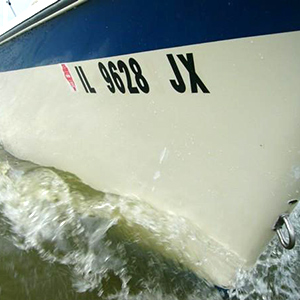
Featured Ads
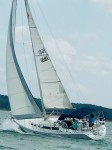
Order Status
Email newsletter.
22-foot Sailboat Comparisons
Catalina 22, chrysler 22.
- BOAT OF THE YEAR
- Newsletters
- Sailboat Reviews
- Boating Safety
- Sails and Rigging
- Maintenance
- Sailing Totem
- Sailor & Galley
- Living Aboard
- Destinations
- Gear & Electronics
- Charter Resources

20 Best Small Sailboats for the Weekender
- By Mark Pillsbury
- Updated: May 24, 2024
In order to go cruising, most of us require a sailboat with a head, a galley, and bunks. The boat, likely a 30-footer and more often a 40-footer, will have electronics for navigation and entertainment, refrigeration if the trip is longer than a coastal hop, an engine for light wind, and, depending on our appetites for food and fun, perhaps a genset to power our toys and appliances.
To go sailing , however, all we really need is a hull, mast, rudder, and sail. To experience the pure joy of sheeting in and scooting off across a lake, bay, or even the open ocean, there’s nothing better than a small sailboat – we’re talking sailboats under 25 feet. You can literally reach out and touch the water as it flows past. You instantly feel every puff of breeze and sense every change in trim.
Some of the boats in this list are new designs, others are time-tested models from small sailboat manufacturers, but every one is easy to rig, simple to sail, and looks like a whole lot of fun either for a solo outing on a breezy afternoon or to keep family and friends entertained throughout your entire sailing season. This list is made up of all types of sailboats , and if you’re looking for a list of some of the best small sailboats for beginners, you’ll find exactly that here.
Any one of these popular boats could be labeled as a trailerable sailboat, daysailer, or even a weekender sailboat. And while most would be labeled as a one or two person sailboat, some could comfortably fit three or even four people.
– CHECK THE WEATHER – The weather changes all the time. Always check the forecast and prepare for the worst case. Safety Tip Provided by the U.S. Coast Guard
Marblehead 22 Daysailer
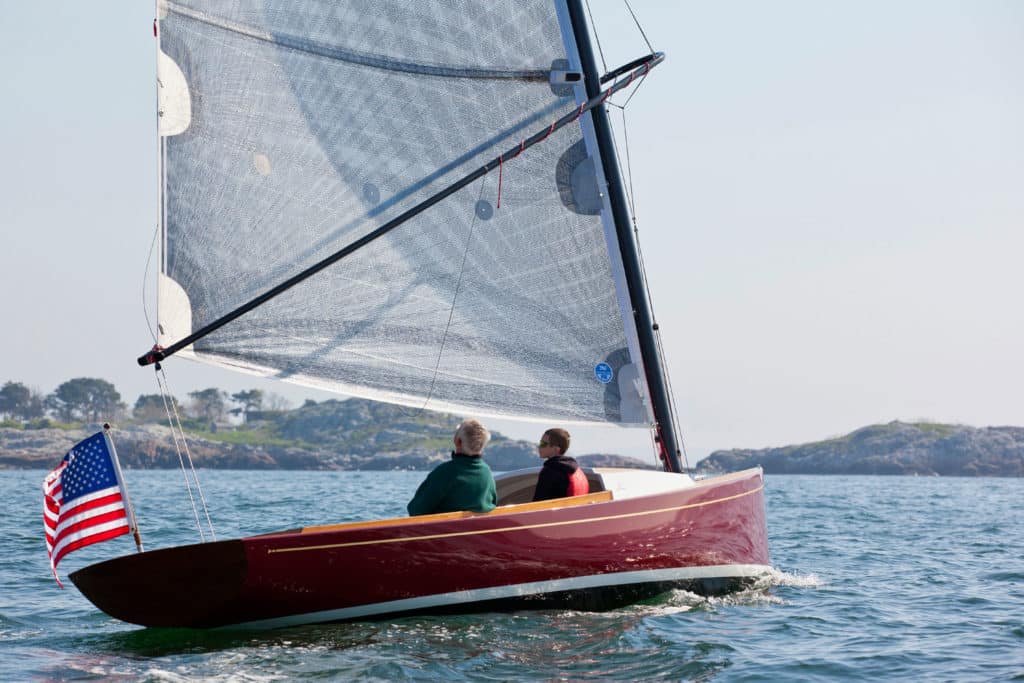
If you have an eye for elegant lines and your heart goes pitter-patter over just the right amount of overhang beneath a counter transom, the Marblehead 22 daysailer, designed by Doug Zurn and built by Samoset Boatworks in Boothbay, Maine, will definitely raise your pulse. Traditional-looking above the waterline and modern beneath, the cold-molded hull sports a deep bulb keel and a Hall Spars carbon-fiber mast with a wishbone rig and square-top main. The 11-foot-9-inch cockpit can seat a crowd, and a small cuddy forward will let you stow your friends’ gear for the day. samosetboatworks.com
Catalina 22 Sport
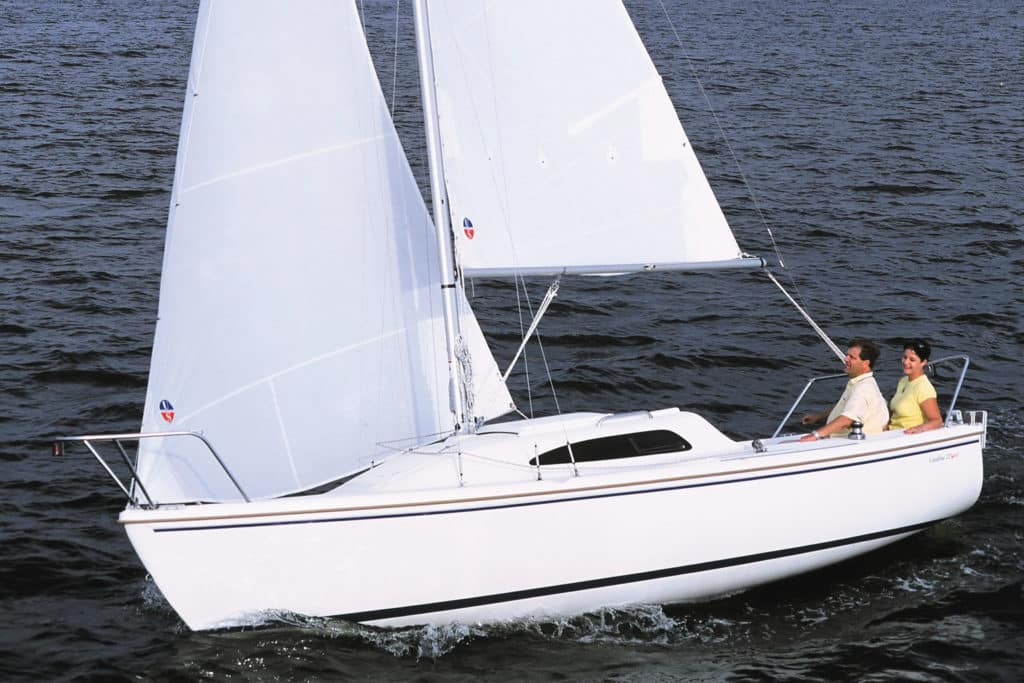
Many a harbor plays host to an active fleet of Catalina 22s, one of the most popular small sailboats over the years, given its basic amenities and retractable keel, which allows it to be easily trailered. Recently, the company introduced the Catalina 22 Sport, an updated design that can compete with the older 22s. The boat features a retractable lead keel; a cabin that can sleep four, with a forward hatch for ventilation; and a fractional rig with a mainsail and a roller-furling jib. Lifelines, a swim ladder, and an engine are options, as are cloth cushions; vinyl cushions are standard. The large cockpit will seat a crowd or let a mom-and-pop crew stretch out and enjoy their sail. It’s clear why the Catalina 22 is one of the best sailboats under 25 feet. catalinayachts.com
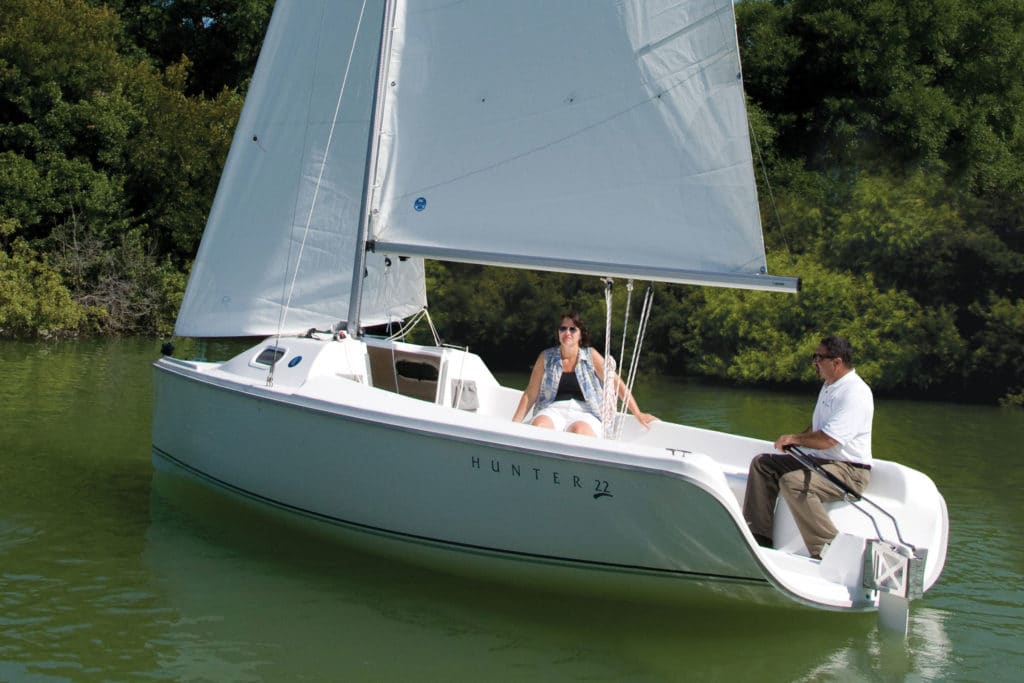
With its large, open-transom cockpit and sloop rig, the Hunter 22 makes a comfortable daysailer for family and friends. But with its cuddy cabin, twin bunks, optional electrical system, opening screened ports, and portable toilet, a parent and child or a couple could comfortably slip away for an overnight or weekend. Add in the optional performance package, which includes an asymmetric spinnaker, a pole, and a mainsheet traveler, and you could be off to the races. The boat features a laminated fiberglass hull and deck, molded-in nonskid, and a hydraulic lifting centerboard. Mount a small outboard on the stern bracket, and you’re set to go. marlow-hunter.com
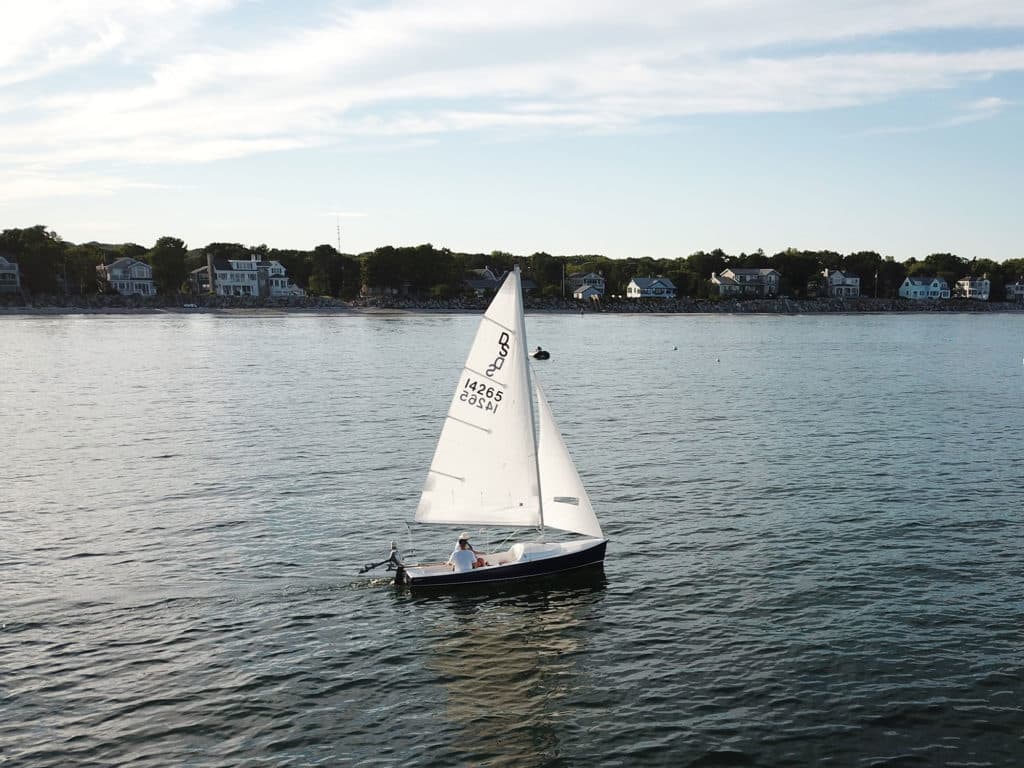
Not sure whether you want to race, cruise or just go out for an afternoon sail? Since 1958, sailors have been having a ball aboard the Uffa Fox/George O’Day-designed Daysailer. Fox, who in the 1950s was on the cutting edge of planning-dinghy design, collaborated with Fall River, Massachusetts boatbuilder O’Day Corp. to build the 16-foot Daysailer, a boat that features a slippery hull and a small cuddy cabin that covers the boat roughly from the mast forward. Thousands of Daysailers were built by various builders, and they can be found used for quite affordable prices. There are active racing fleets around the US, and new Daysailers are still in production today, built by Cape Cod Ship Building. capecodshipbuilding.com
BayRaider from Swallow Boats
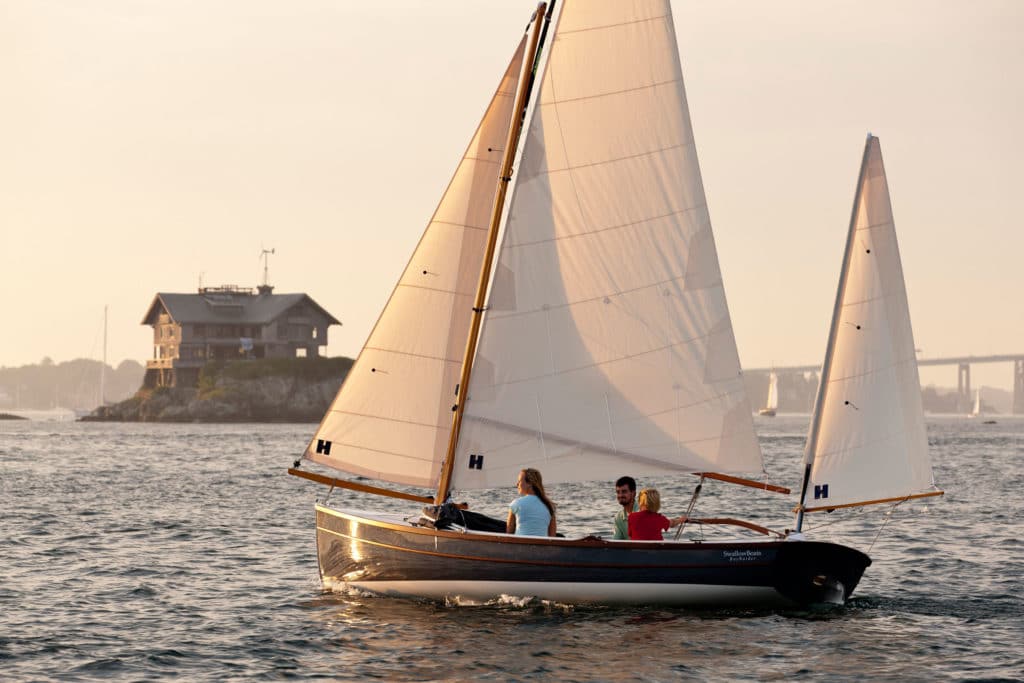
Easy to rig and trailer, the BayRaider from England’s Swallow Yachts is a relative newcomer to the small-boat market in the United States. Nearly all of its 19 feet 9 inches is open cockpit, though a spray hood can be added to keep the forward sections dry. The BayRaider is ketch-rigged with a gunter-style mainmast. The topmast and mizzen are both carbon-fiber, which is an option for the mainmast as well. The BayRaider can be sailed with a dry hull in lighter conditions or with 300 pounds of water ballast to increase its stability. With the centerboard and hinged rudder raised, the boat can maneuver in even the thinnest water.
$28,900, (904) 234-8779, swallowyachts.com
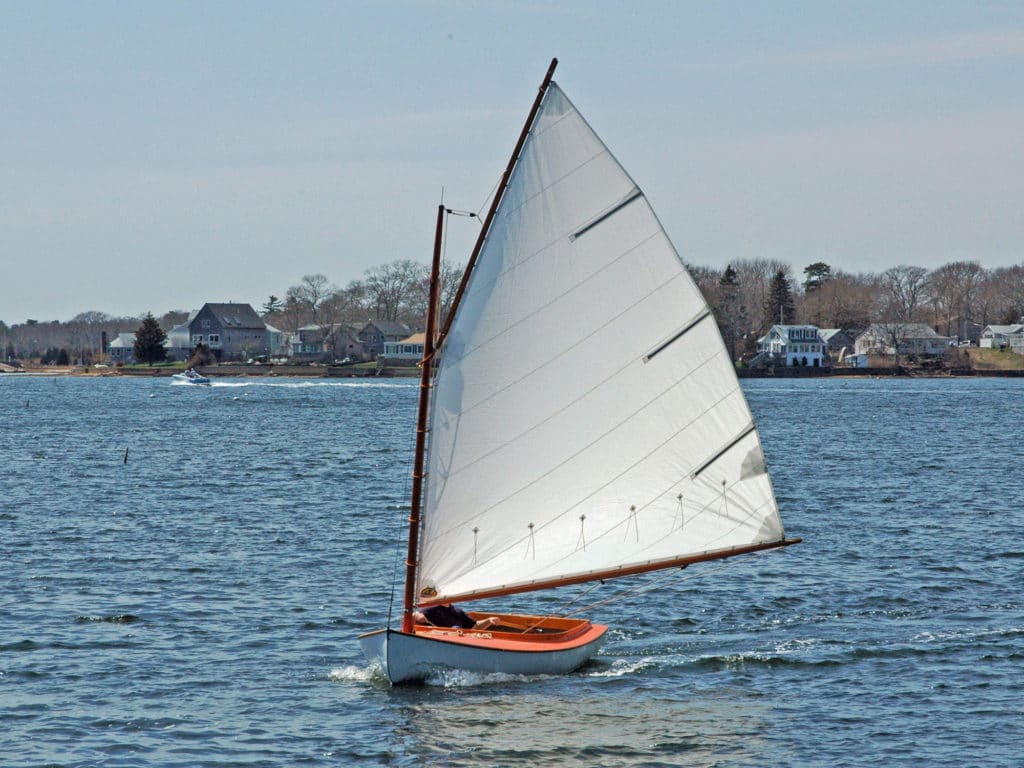
Big fun can come in small packages, especially if your vessel of choice happens to be the 12 ½-foot Beetle Cat. Designed by John Beetle and first built in 1921, the wooden shallow draft sailboat is still in production today in Wareham, Massachusetts at the Beetle Boat Shop. With a draft of just 2 feet, the boat is well-suited for shallow bays, but equally at home in open coastal waters. The single gaff-rigged sail provides plenty of power in light air and can be quickly reefed down to handle a blow. In a word, sailing a Beetle Cat is fun. beetlecat.com
– LEARN THE NAVIGATION RULES – Know the “Rules of the Road” that govern all boat traffic. Be courteous and never assume other boaters can see you. Safety Tip Provided by the U.S. Coast Guard
West Wight Potter P 19
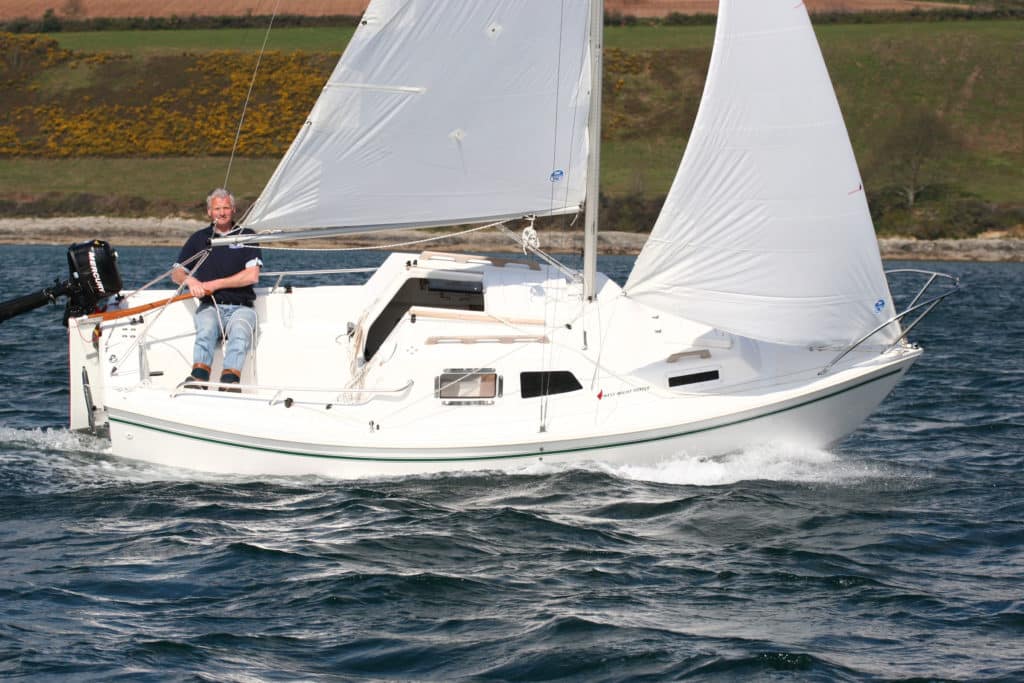
With berths for four and a workable galley featuring a cooler, a sink, and a stove, West Wight Potter has packed a lot into its 19-foot-long P 19. First launched in 1971, this is a line of boats that’s attracted a true following among trailer-sailors. The P 19′s fully retractable keel means that you can pull up just about anywhere and go exploring. Closed-cell foam fore and aft makes the boat unsinkable, and thanks to its hard chine, the boat is reportedly quite stable under way. westwightpotter.com
NorseBoat 17.5
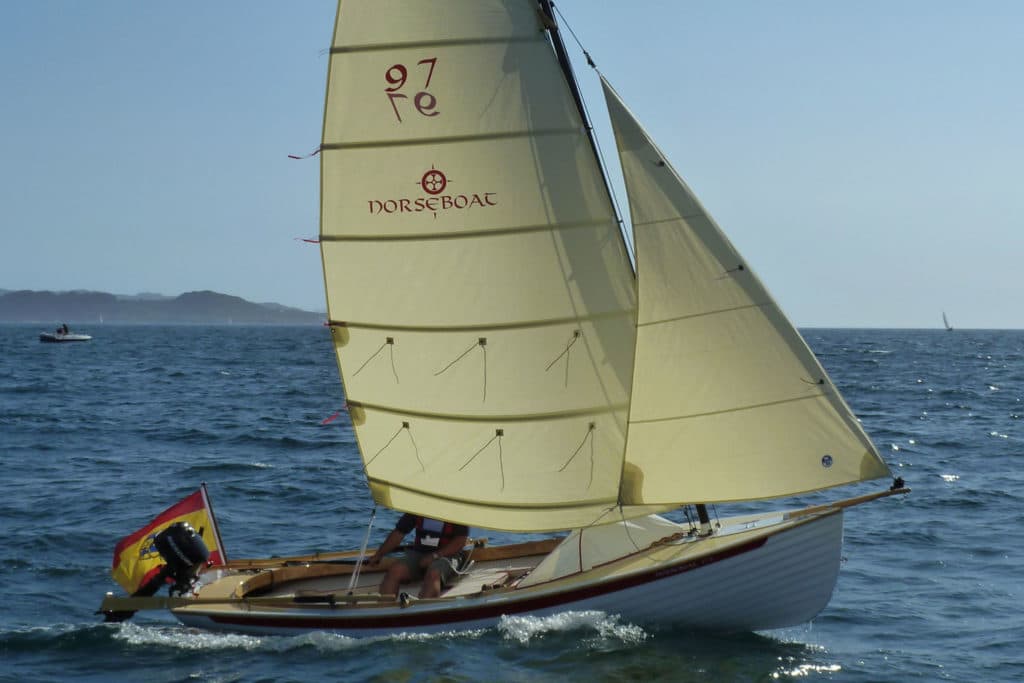
Designed for rowing and sailing (a motor mount is optional), the Canadian-built NorseBoat 17.5—one of which was spotted by a CW editor making its way through the Northwest Passage with a two-man crew—features an open cockpit, a carbon-fiber mast, and a curved-gaff rig, with an optional furling headsail set on a sprit. The lapstrake hull is fiberglass; the interior is ply and epoxy. The boat comes standard with two rowing stations and one set of 9-foot oars. The boat is designed with positive flotation and offers good load-carrying capacity, which you could put to use if you added the available canvas work and camping tent. NorseBoats offers a smaller sibling, the 12.5, as well; both are available in kit form.
$19,000, (902) 659-2790, norseboat.com
Montgomery 17
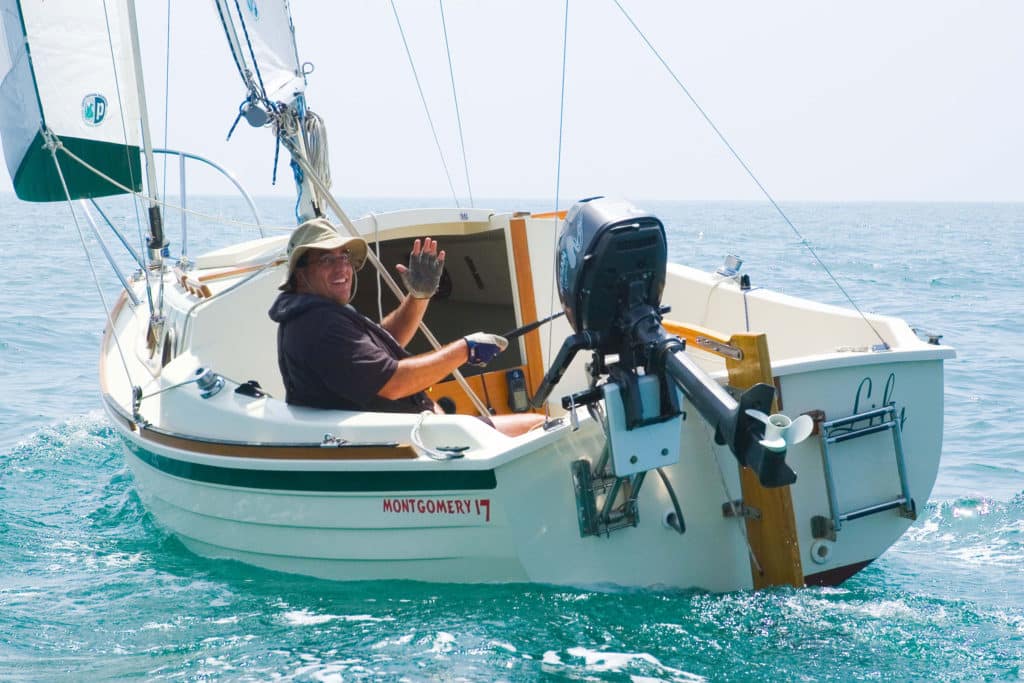
Billed as a trailerable pocket cruiser, the Montgomery 17 is a stout-looking sloop designed by Lyle Hess and built out of fiberglass in Ontario, California, by Montgomery Boats. With a keel and centerboard, the boat draws just under 2 feet with the board up and can be easily beached when you’re gunkholing. In the cuddy cabin you’ll find sitting headroom, a pair of bunks, a portable toilet, optional shore and DC power, and an impressive amount of storage space. The deck-stepped mast can be easily raised using a four-part tackle. The builder reports taking his own boat on trips across the Golfo de California and on visits to California’s coastal islands. Montgomery makes 15-foot and 23-foot models, as well. If you’re in search of a small sailboat with a cabin, the Montgomery 17 has to be on your wish list.
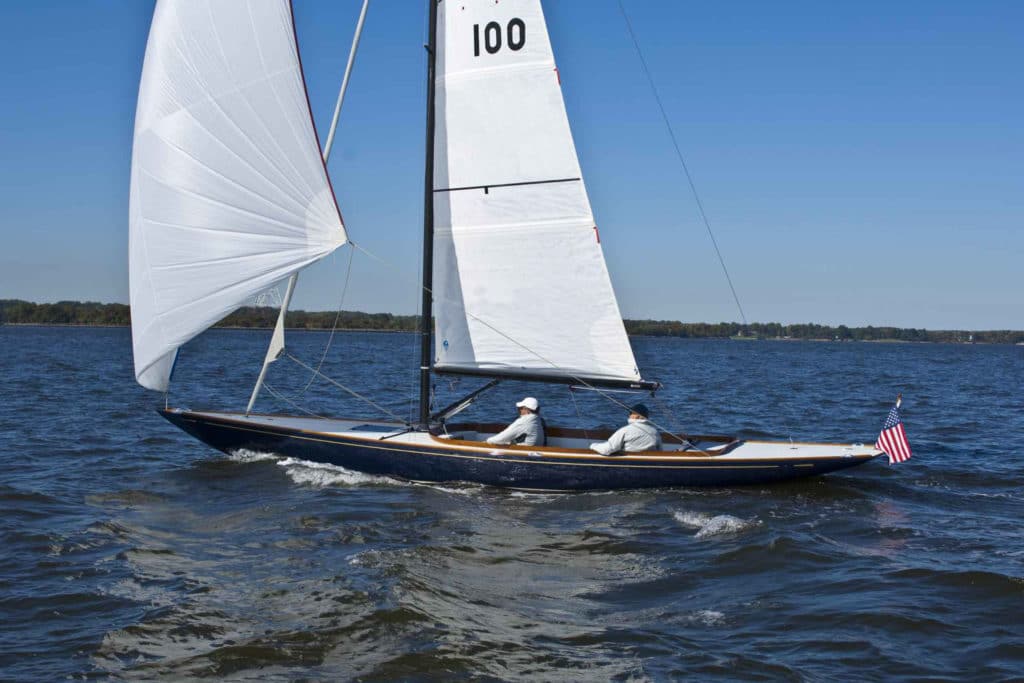
With long overhangs and shiny brightwork, the CW Hood 32 is on the larger end of the daysailer spectrum. Designers Chris Hood and Ben Stoddard made a conscious decision to forego a cabin and head in favor of an open cockpit big enough to bring 4 or 5 friends or family out for an afternoon on the water. The CW Hood 32 is sleek and graceful through the water and quick enough to do some racing, but keeps things simple with a self-tacking jib and controls that can be lead back to a single-handed skipper. A top-furling asymmetrical, electric sail drive and Torqeedo outboard are all optional. The CW Hood 32 makes for a great small family sailboat. cwhoodyachts.com
Sun Cat from Com-Pac
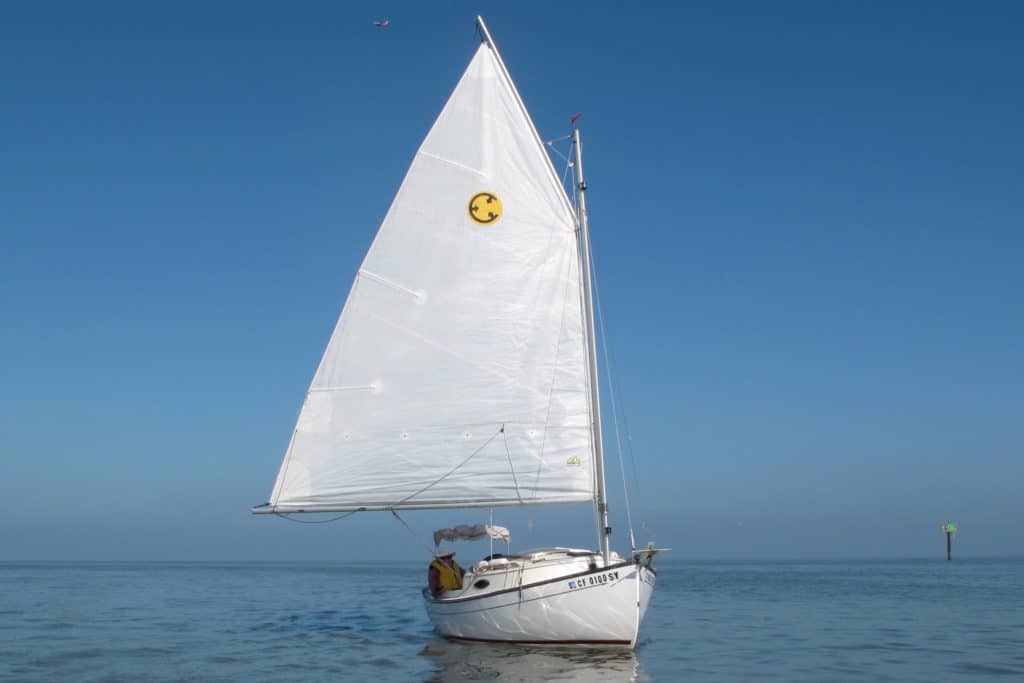
Shallow U.S. East Coast bays and rock-strewn coasts have long been graced by cat boats, whose large, gaff-rigged mainsails proved simple and powerful both on the wind and, better yet, when reaching and running. The 17-foot-4-inch Sun Cat, built by Com-Pac Yachts, updates the classic wooden cat with its fiberglass hull and deck and the easy-to-step Mastender Rigging System, which incorporates a hinged tabernacle to make stepping the mast a one-person job. If you want a personal sailboat ideal for solo sailing, the Sun Can is a great choice. Belowdecks, the twin 6-foot-5-inch berths and many other features and amenities make this cat a willing weekender.
$19,800, (727) 443-4408, com-pacyachts.com
Catalina 16.5
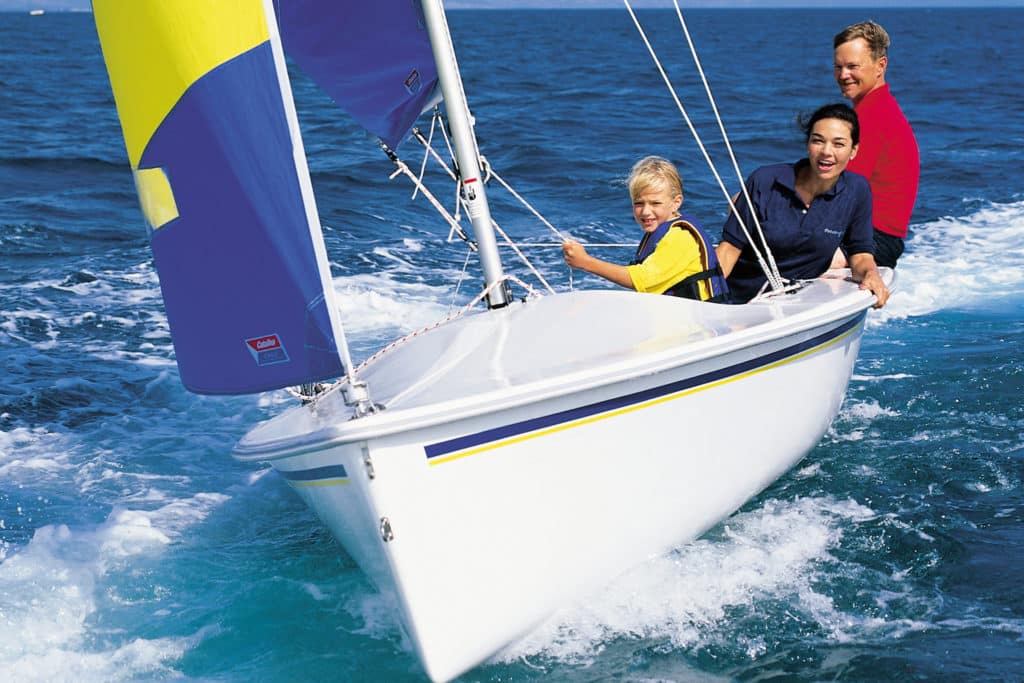
The Catalina 16.5 sits right in the middle of Catalina Yachts’ line of small sailboats, which range from the 12.5 to the 22 Capri and Sport, and it comes in both an easy-to-trailer centerboard model and a shoal-draft fixed-keel configuration. With the fiberglass board up, the 17-foot-2-inch boat draws just 5 inches of water; with the board down, the 4-foot-5-inch draft suggests good windward performance. Hull and deck are hand-laminated fiberglass. The roomy cockpit is self-bailing, and the bow harbors a good-sized storage area with a waterproof hatch. catalinayachts.com
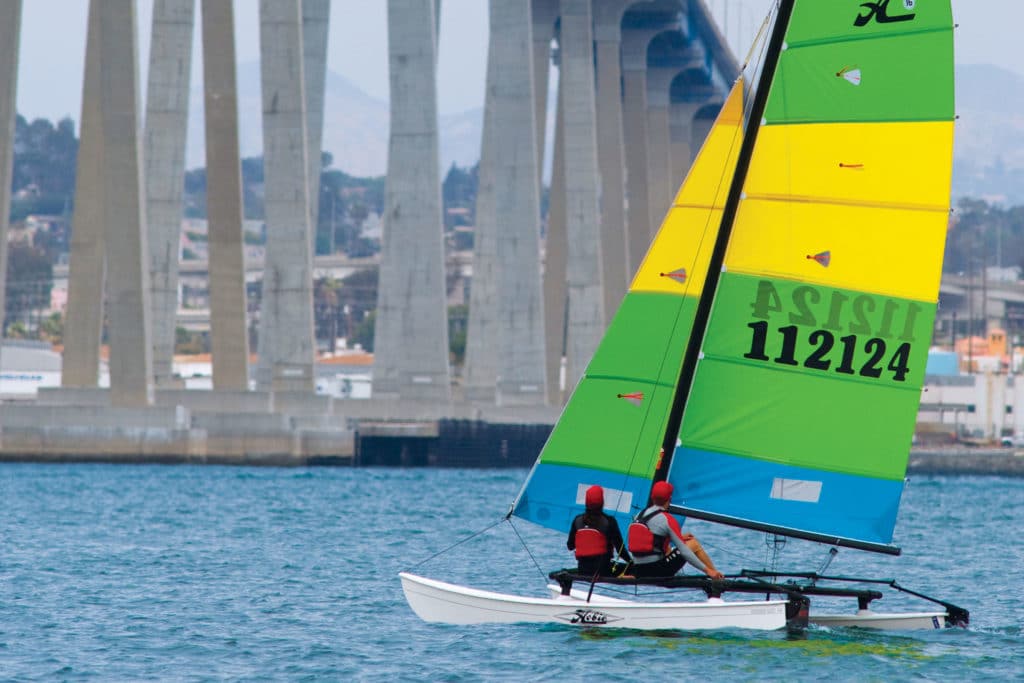
No roundup of best small sailboats (trailerable and fun too) would be complete without a mention of the venerable Hobie 16, which made its debut in Southern California way back in 1969. The company has introduced many other multihulls since, but more than 100,000 of the 16s have been launched, a remarkable figure. The Hobie’s asymmetric fiberglass-and-foam hulls eliminate the need for daggerboards, and with its kick-up rudders, the 16 can be sailed right up to the beach. Its large trampoline offers lots of space to move about or a good place to plant one’s feet when hanging off the double trapezes with a hull flying. The boat comes with a main and a jib; a spinnaker, douse kit, trailer, and beach dolly are optional features. hobiecat.com
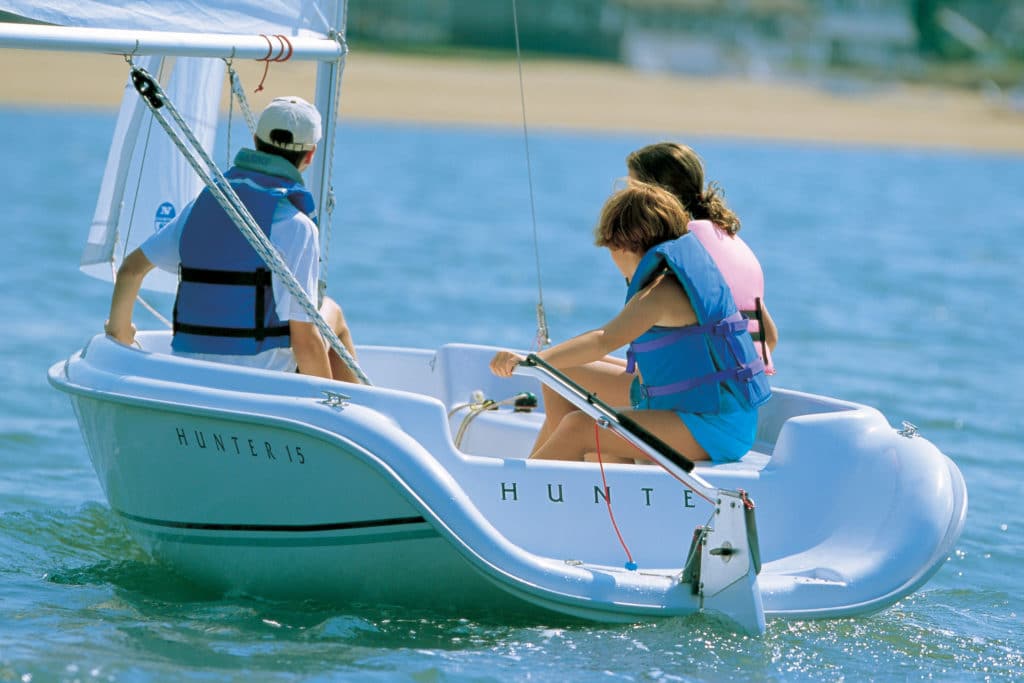
Novice sailors or old salts looking for simplicity could both enjoy sailing the Hunter 15. With a fiberglass hull and deck and foam flotation, the boat is sturdily built. The ample freeboard and wide beam provide stability under way, and the heavy-duty rubrail and kick-up rudder mean that you won’t have to worry when the dock looms or the going grows shallow. Both the 15 and its slightly larger 18-foot sibling come standard with roller-furling jibs.
$6,900/$9,500 (boat-show prices for the 15 and 18 includes trailers), (386) 462-3077, marlow-hunter.com
– CHECK THE FIT – Follow these guidelines to make sure your life jacket looks good, stays comfortable and works when you need it. Safety Tip Provided by the U.S. Coast Guard
Super Snark
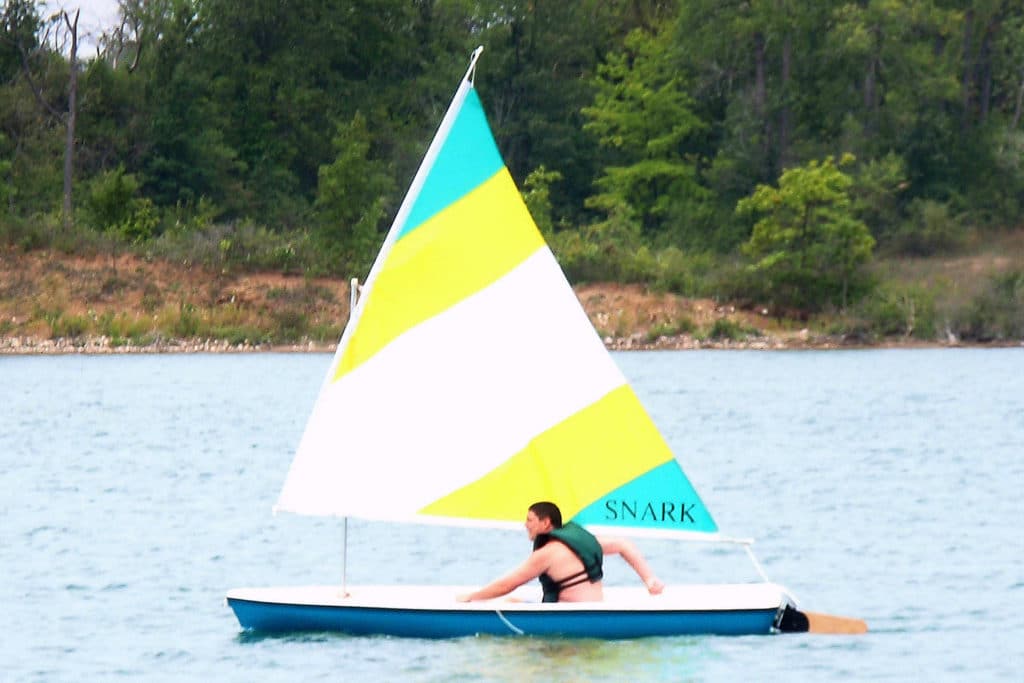
Under various owners, the Snark brand of sailboats, now built by Meyers Boat Co., has been around since the early 1970s. The Super Snark, at 11 feet, is a simple, easily car-topped daysailer that’s fit out with a lateen rig and sail. Billed as unsinkable, the five boats in the company’s line are built with E.P.S. foam, with the external hull and deck vacuum-formed to the core using an A.B.S. polymer. The Super Snark weighs in at 50 pounds, and with a payload capacity of 310 pounds, the boat can carry two.
$970, (800) 247-6275, meyersboat.com
Norseboat 21.5
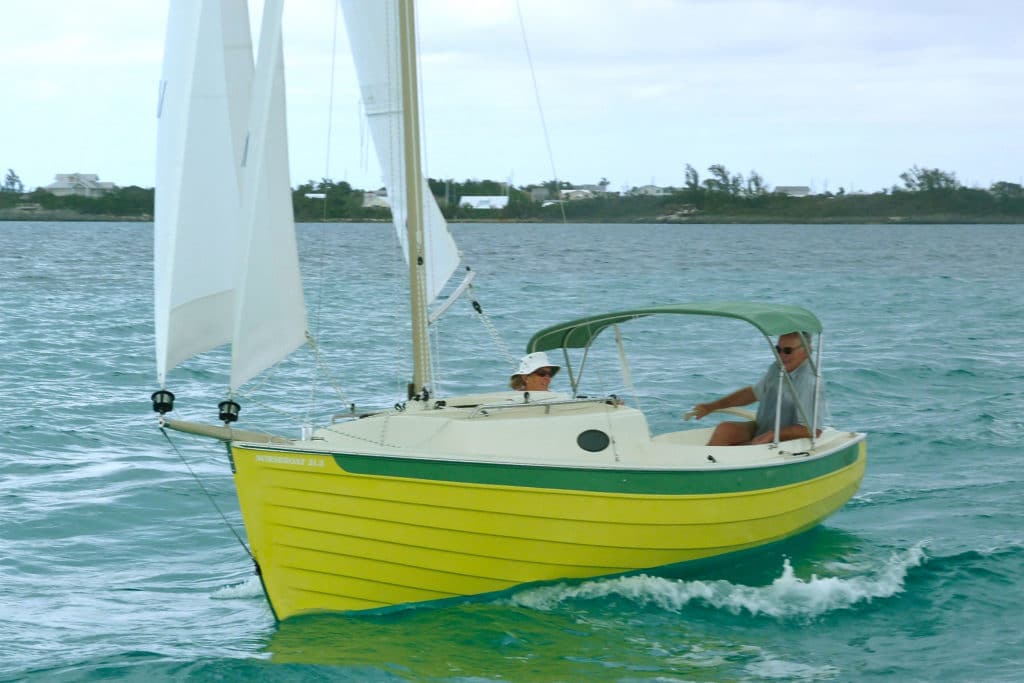
Built in Canada, the NorseBoat 21.5 is a rugged looking craft that comes in a couple of configurations: one with an open cockpit and small doghouse, and another with a smaller cockpit and cabin that houses a double berth for two adults and optional quarter berths for the kids. Both carry NorseBoat’s distinctive looking carbon fiber gaff-rigged mast with main and jib (a sprit-set drifter is optional), and come with a ballasted stub keel and centerboard. Because of its lightweight design, the boat can be rowed and is easily trailered.
$36,000 (starting), 902-659-2790, norseboat.com
Flying Scot
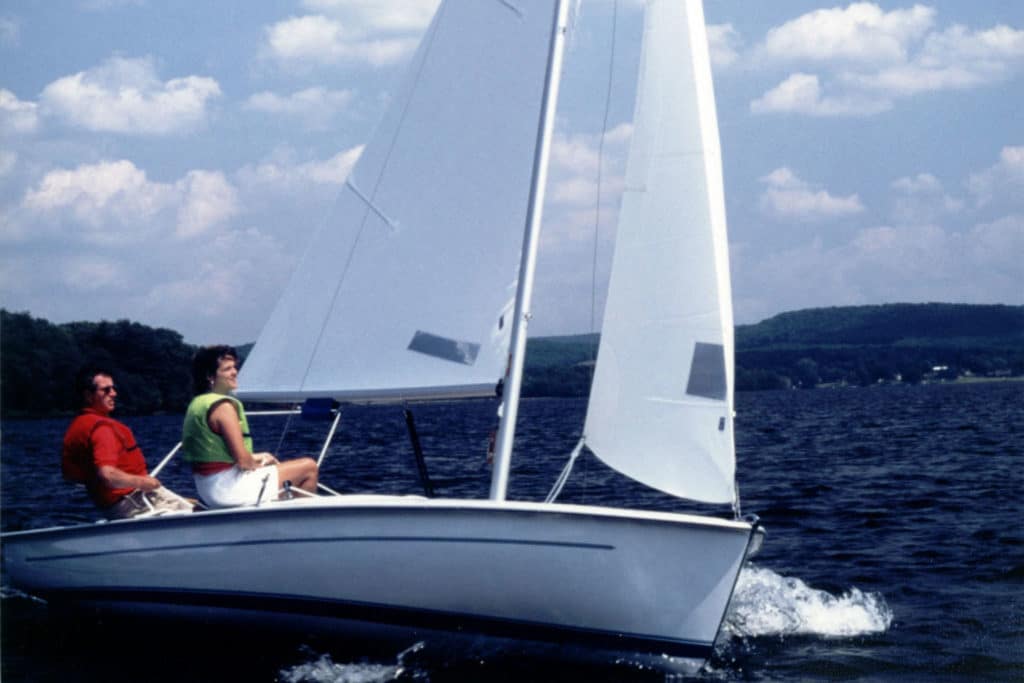
Talk about time-tested, the 19-foot Flying Scot has been in production since 1957 and remains a popular design today. Sloop rigged, with a conventional spinnaker for downwind work, the boat is an easily sailed family boat as well as a competitive racer, with over 130 racing fleets across the U.S. Its roomy cockpit can seat six to eight, though the boat is often sailed by a pair or solo. Hull and deck are a fiberglass and balsa core sandwich. With the centerboard up, the boat draws only eight inches. Though intended to be a daysailer, owners have rigged boom tents and berths for overnight trips, and one adventurous Scot sailor cruised his along inland waterways from Philadelphia to New Orleans.
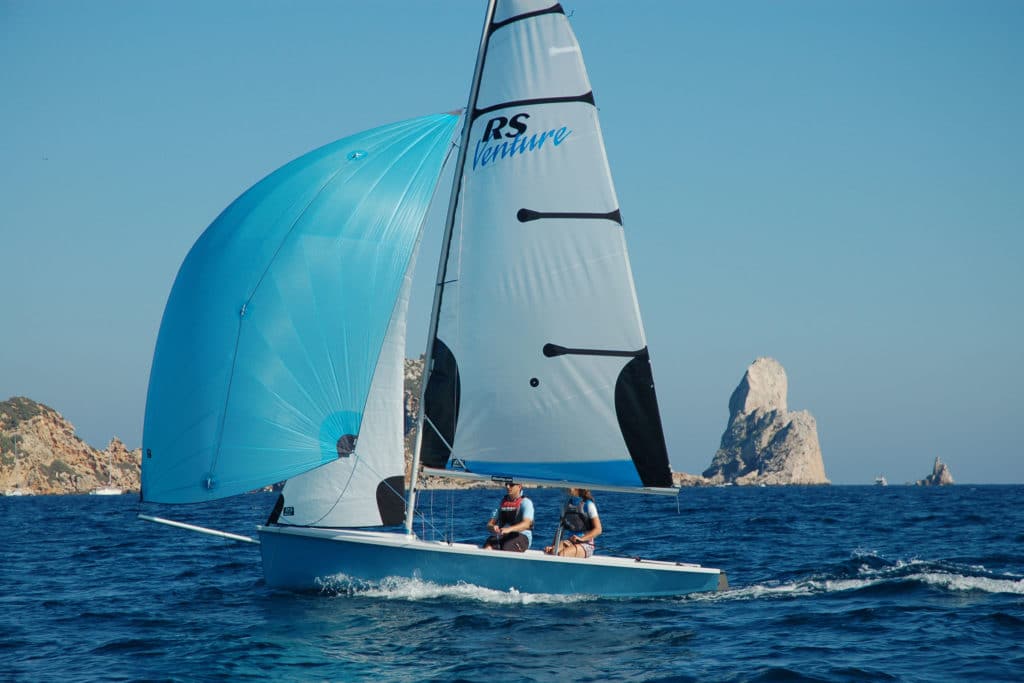
Known primarily for its line of racing dinghys, RS Sailing also builds the 16-foot, 4-inch Venture, which it describes as a cruising and training dinghy. The Venture features a large, self-draining cockpit that will accommodate a family or pack of kids. A furling jib and mainsail with slab reefing come standard with the boat; a gennaker and trapeze kit are options, as is an outboard motor mount and transom swim ladder. The deck and hull are laid up in a fiberglass and Coremat sandwich. The Venture’s designed to be both a good performer under sail, but also stable, making it a good boat for those learning the sport.
$14,900, 203-259-7808, rssailing.com
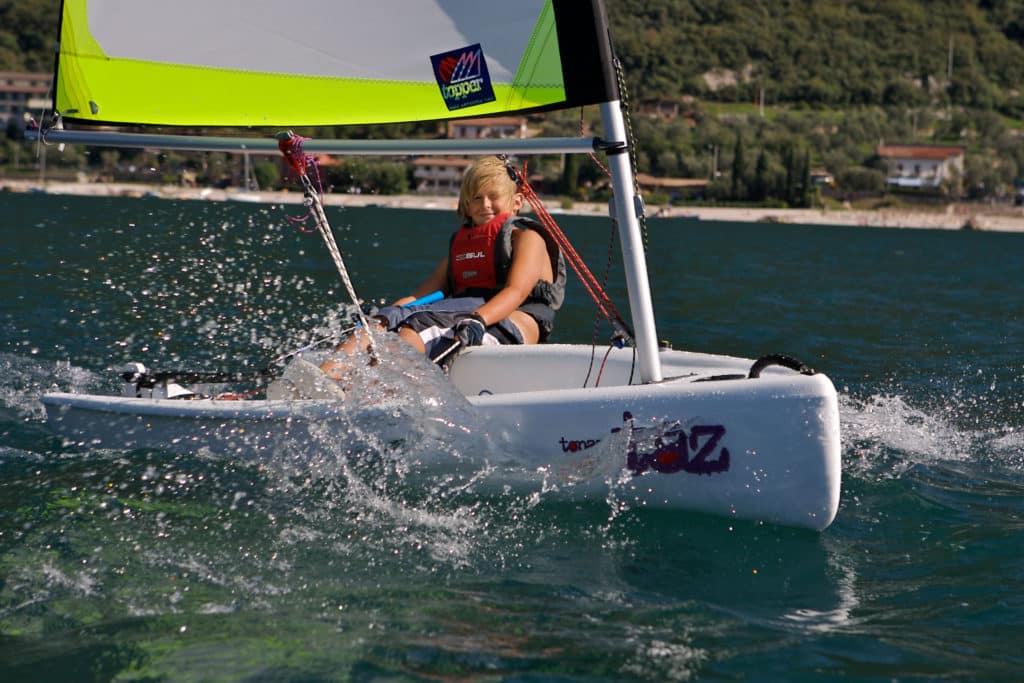
Topper makes a range of mono- and multihull rotomolded boats, but the model that caught one editor’s eye at Strictly Sail Chicago was the Topaz Taz. At 9 feet, 8 inches LOA and weighing in at 88 pounds, the Taz is not going to take the whole crowd out for the day. But, with the optional mainsail and jib package (main alone is for a single child), the Taz can carry two or three kids or an adult and one child, and would make a fun escape pod when tied behind the big boat and towed to some scenic harbor. The hull features Topper’s Trilam construction, a plastic and foam sandwich that creates a boat that’s stiff, light, and durable, and shouldn’t mind being dragged up on the beach when it’s time for a break.
$2,900 (includes main and jib), 410-286-1960, topazsailboats.com
WindRider WRTango
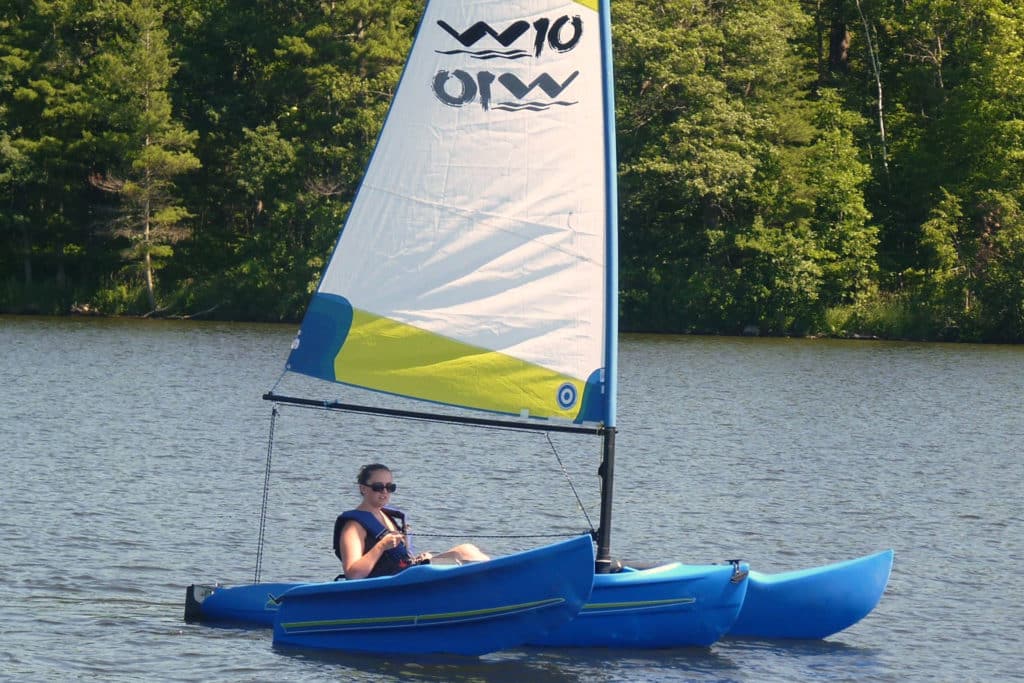
WRTango, a fast, sturdy, 10-foot trimaran that’s easy to sail, is the newest portable craft from WindRider International. It joins a line that includes the WR16 and WR17 trimarans. The Tango features forward-facing seating, foot-pedal steering, and a low center of gravity that mimics the sensation of sitting in a kayak. It weighs 125 pounds (including the outriggers and carbon-fiber mast), is extremely stable, and has single-sheet sail control. The six-inch draft and kick-up rudder make it great for beaching, while the hull and outriggers are made of rotomolded polyethylene, so it can withstand running into docks and being dragged over rocks.
$3,000, 612-338-2170, windrider.com
- More: 21 - 30 ft , Boat Gallery , day sailing , dinghy , Sailboat Reviews , Sailboats , under 20 ft
- More Sailboats

For Sale: 1983 Little Harbor 44

Sailboat Preview: ClubSwan 28 by Nautor Swan

Sailboat Review: Vision 444

Sailboat Preview: Lagoon 43
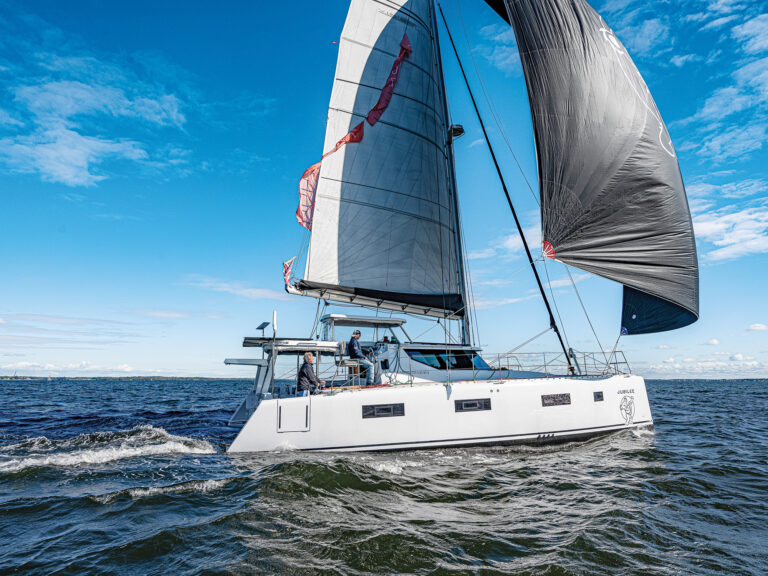
When the Wind Goes Light

Sailor & Galley: Ice Cream, Anytime
- Digital Edition
- Customer Service
- Privacy Policy
- Email Newsletters
- Cruising World
- Sailing World
- Salt Water Sportsman
- Sport Fishing
- Wakeboarding
Review of the O'Day Mariner 19 Sailboat
Ahunt/Wikimedia CC 2.0
For over 40 years, the 19-foot Mariner sailboat has been a popular daysailer. Based on the hull of the fast, stable Rhodes 19, the Mariner added a small cabin and other features. Built by O'Day from 1963 through 1979, and currently, by Stuart Marine, the Mariner was marketed as a family daysailer.
As one of the first affordable, trailerable fiberglass sailboats, the Mariner has been popular on lakes and protected bays every since. With its roomy cockpit, wide-beamed stability, and easy sailing characteristics, the Mariner deserves its reputation and is still among the best general-purpose sailboats of its size.
- Excellent boat for learning to sail and for family daysailing
- Stable and handles well if wind or waves kick up
- Very large cockpit provides comfortable sailing for 4 to 6 crew
- Solid and well constructed; older boats have held up well
- Self-righting and positive flotation
- Cabin is useful for daysailing but cramped for sleeping aboard for long
- Older boats susceptible to leaks in centerboard locker (if abused by previous owners)
- Early models lacked self-bailing cockpits
Specifications
- Length overall: 19 feet 2 inches
- Beam: 7 feet
- Draft: keelboat: 3 feet 3 inches - centerboard up: 10 inches - centerboard down: 4 feet 11 inches
- Empty weight: keelboat: 1435 lbs. - centerboard: 1305 lbs.
- Sail area (main and fractional jib): 185 sqft
- Mast height (deck-stepped): 27 feet 10 inches
- Rudder: keelboat: fixed - centerboard: kick-up
- Recommended outboard engine: 2-6 HP
- MSRP $24,000 depending on options - widely available used (NADA Marine Guide average retail price for 1977 models: $2,110)
- Parts readily available for older boats, plus information from owners and class associations
Review of the Mariner 19 Sailboat
In the 1950s the Rhodes 19 was a popular wooden racing and daysailing sailboat. In 1963 Olympic gold-medal sail racer George O'Day bought the hull design, redesigned the topsides with a small cabin, and began producing one of the first affordable fiberglass family sailboats, the Mariner 19. While still producing a keel version, O'Day offered a centerboard option that improved trailer launching and allowed the Mariner to sail up to a beach.
The Mariner rapidly became a popular club one-design racer but also a good family boat seen widely on lakes and bays. By 1979 O'Day had produced almost 3800 Mariners - a huge number for any one model - and after O'Day discontinued the Mariner to focus on larger cruising sailboats, Spindrift and then Stuart Marine continued building the Mariner. The Mariner is still being built - probably the longest continuous production run of any sailboat model ever.
In the late 1960s and 1970s, design changes increased the Mariner's popularity for family sailing. The 2+2 model added two more berths in the cabin, for a total of four, although the cabin really is too cramped to call this boat a cruiser. (Sleeping aboard is more like backpack camping.) The cockpit length was increased to the transom, making a much larger space than in most boats of this size.
The current model includes nonskid on deck and the cockpit seats, all control lines led to the cockpit, positive flotation, and a kick-up rudder on the centerboard model that allows the boat into very shoal waters. With its wide beam and fractional jib that reduces heeling, the Mariner is stable and safe to sail in most conditions.
Virtually all Mariner owners say they'd buy one again - they have no regrets. The features most commonly cited are its stability ("virtually untippable"), its oversized cockpit (where you spend most of your time anyway), and how easily it can be launched (even on a shallow boat ramp).
Perhaps most important, the Mariner is very forgiving of the sailor's mistakes - and thus is an excellent beginning boat. The few complaints of Mariner owners focus on the cramped interior, where the cabin roof is too low for taller people to sit on the settees without bumping your head.
Good Mariners can readily be found on the used market. There are more likely to be problems with an old trailer (rust, wear and tear) than the fiberglass boat itself unless it was abused by a previous owner. For a new owner, The Mariner Class Association offers many benefits, including boat information, sailing tips, sources for parts, and a newsletter.
If you're interested in a small sailboat with a bigger cabin for pocket cruising, check out the West Wight Potter 19 - an outstanding small sailboat. If you’re thinking about a trailerable sailboat like the Potter 19, remember that one of the great advantages is the ability to take it easily to other sailing destinations, such as heading to the Florida Keys in the winter.
Here’s an inexpensive, effective way to control your tiller if you have to let go for a moment while sailing. Need a new outboard motor for your small sailboat? Check out the great new propane-powered outboards from Lehr. If you own a trailer for your boat, be sure you maintain it adequately both to keep it working into the future but to stay safe when using it.
West Wight Potter 19 Sailboat Review
The 8 Best Hoka Shoes of 2024, Tested and Reviewed
The 10 Best Inflatable Stand-Up Paddleboards of 2024, Tested and Reviewed
Learn the Parts of a Sailboat and How to Communicate Them
Owner's Review of the MacGregor 26 Sailboat Models
The 8 Best Camping Tarps of 2024
The 7 Best Travel Car Seats of 2024
The 9 Best Slip-On Sneakers for Men of 2024, Tested and Reviewed
The 7 Best Travel Cribs of 2024, Tested and Reviewed
Learn How to Sail a Small Sailboat
The 9 Best Camping Cots of 2024, Tested and Reviewed
Buying a Sailboat: Sloop vs. Ketch
How to Rig Your Small Sailboat and Prepare to Sail
The 8 Best Beach Canopies of 2024, Tested and Reviewed
The 10 Best Towable Tubes of 2024
The 11 Best Hardside Luggage Bags of 2024, Tested and Reviewed

COMMENTS
Discount Sails-O'Day_22. Electric Yacht. New Rudders. SeaWaterPro. SBD App - BR. top 1 ads row1. top 2 ads row2. top 3 ads row2. ... 22.00 ft / 6.71 m: J: 8.00 ft / 2.44 m: P: ... Related Sailboats: O'DAY 22 MH : Download Boat Record: Notes. One of the most successful of all O'Day models with more than 3000 built. ...
By. Darrell Nicholson. -. Published: June 14, 2000 Updated: April 14, 2020. 1. O'Day Boats was around a long time by fiberglass boatbuilding standards—about 30 years. Originally O'Day was a leader in small boats typified by the Fox-designed Day Sailer. O'Day 22 Specifications. By the early '70s O'Day had moved into the trailerable ...
The O'Day 22 is an American trailerable sailboat that was designed by C. Raymond Hunt & Associates as a cruiser and first built in 1972. The O'Day 22 design was initially offered with a masthead sloop rig, but, after 1980, used a fractional rig. ... with a mast about 4.00 ft (1.22 m) higher. ...
ODAY preowned sailboats for sale by owner. ODAY used sailboats for sale by owner. Home. Register & Post. View All Sailboats. ... O'Day 22: Length: 22' Draft: 2' Year: 1983: Type: cruiser: Hull: fiberglass monohull: Engine: ... 32' Bayfield 32C 32 ft Cutter Costa Del Sol El Salvador Asking $8,000. 22' Hinterhoeller Nonsuch 22 Punta Gorda ...
O'Day 22 is a 21′ 8″ / 6.6 m monohull sailboat designed by Raymond Hunt (C.R. Hunt & Assoc.) and built by O'Day Corp. between 1972 and 1983. ... The lower a boat's ratio is, the less power it takes to drive the boat to its nominal hull speed or beyond. Read more. Formula. D/L = (D ÷ 2240) ÷ (0.01 x LWL)³ D: Displacement of the boat in ...
#Oday,My Oday 22 Sailboat after putting in upgrades i.e. Solar Panel for charging battery while at dock, gas barbecue, stereo radio with indoor & outdoor spe...
This is simply a few minutes from a light sailing day on the Hudson River, between Stony Point and Bucanan.The boat is a 1973 22 foot O'Day. It has a 700 pou...
O'Day 22 Sailboat For Family Cruising (1973) ... The O'Day 22's fixed, long, thin keel with permanent inside lead ballast is truly a design breakthrough. Combined with our hard bilged hull...the 22's stability and performance in all kinds of weather will surprise the most experienced sailors. ... Sail Area: 196 sq. ft. STANDARD BOAT. $2795 ...
The O'day 22 is a 21.67ft fractional sloop designed by C. Raymond Hunt & Assoc. and built in fiberglass by O'Day Corp. between 1972 and 1983. 3159 units have been built. The O'day 22 is a light sailboat which is a reasonably good performer. It is reasonably stable / stiff and has a low righting capability if capsized. It is best suited as a day ...
22'. $ 10,000. Stock #247848 - 1978 O'day 22 trailerable sloop, TOHATSU power, compact size makes for ease of maneuverabilityWe are looking for people all over the country who share our love for boats. If you have a passion for our product and like the idea of working from home, please visit SellBoatsAndRVs [dot] …. 22' O'Day. 1976. 22'. $ 2,500.
O'Day 22 or 222, well...it really depends on what your needs are. The 22 has a more "big-Boat" style cabin, as others have mantioned, she has a head with some privacy (still open to v-berth), a hanging locker (small, but true), and may be much less expensive. The 222 will be newer, might be in better condition, has a more open interior, head is ...
Find O-day boats for sale in your area & across the world on YachtWorld. Offering the best selection of o-day boats to choose from. ... ft. m. Price. to. USD. Year. to. Class. Power. Power-all-power. All power. Power-cruiser. Cruiser. Sail. Sail-all-sail. ... 2025 Jasper Marine Defender 22. US$146,081. Oaksmith Yachts | Chelan, Washington. 2018 ...
ODay preowned sailboats for sale by owner. ODay used sailboats for sale by owner. Home. Register & Post. View All Sailboats. ... Sailboat Added 22-Jul-2015 More Details: O'Day 35: Length: 35' Beam: 11' 3' Draft: 4' 5' Year: 1985: ... 32' Bayfield 32C 32 ft Cutter Costa Del Sol El Salvador Asking $8,000. 22' Hinterhoeller Nonsuch 22 Punta Gorda ...
1977 ODAY Sailboat 22 ft. $1,500 . Galivants Ferry, South Carolina. Year - Make - Model - Category - Length - Posted Over 1 Month. Boat has patched sails, no head. Needs cleaned up.. Donzi trailer has rust spots. 1974 Oday 22 Sailboat and trailer. $1,900 ...
Notes. Dimensions for masthead rig. (1973-1980) Also available with keel/cb. Draft: 1.25ft - 4.25ft. Later O'Day brochures list the displacement as 2,183 lbs. See O'DAY 22 for more details. Taller masthead rig:
Model 22. Category Cruiser Motorcycles. Length 22.0. Posted Over 1 Month. I have for sale a 1981 O'Day 22 MH Sailboat. $3200 OBO This boat has a 4.5HP 2 stroke Johnson Seahorse outboard. The motor runs great and starts on the second pull. Very light motor. This is a great boat if you are an experienced sailor or just starting out.
Resources for owners of Oday. Photos, downloads, owner modifications, accessories, boats for sale, and more. Serving sailors online since 1997. Contact us. ... Oday Javelin Oday Tempest Oday Outlaw Oday 15 Oday 19 Oday 192 Oday Rhodes-19 Oday 20 Oday 222 Oday 22 Oday 23 Oday 240 Oday 25; Oday 26; Oday 27; Oday 272; Oday 272LE; Oday 28; Oday 280 ...
In comparison to the Catalina 22, the cabin extends to the full width of the boat, which provides a significant increase in cabin space. Also, although the Catalina and Tanzer are both "22" feet long, the C22 is only 21'6", while the T22 is 22'6" -- a full foot longer! Three photos of T22 #1597, which was for sale in Markham, Ontario.
It's clear why the Catalina 22 is one of the best sailboats under 25 feet. catalinayachts.com ... Since 1958, sailors have been having a ball aboard the Uffa Fox/George O'Day-designed Daysailer. ... Boat Gallery, day sailing, dinghy, Sailboat Reviews, Sailboats, under 20 ft; Advertisement More Sailboats; Sailboat Preview: Neel 52 For Sale ...
Jan 6, 2014. #6. Bpb, so that you don't get confused, keep in mind there is significant difference between the O'day 22, and the O'day 222. The 22 is an older style, with the boxier proportioned cabin that is more rounded, with 2 windows per side. The 222 is newer styling, with more of a swept, angled cabin, and a single smoked window per side ...
Find Sail O-day boats for sale in your area & across the world on YachtWorld. Offering the best selection of o-day boats to choose from.
For over 40 years, the 19-foot Mariner sailboat has been a popular daysailer. Based on the hull of the fast, stable Rhodes 19, the Mariner added a small cabin and other features. Built by O'Day from 1963 through 1979, and currently, by Stuart Marine, the Mariner was marketed as a family daysailer. As one of the first affordable, trailerable ...